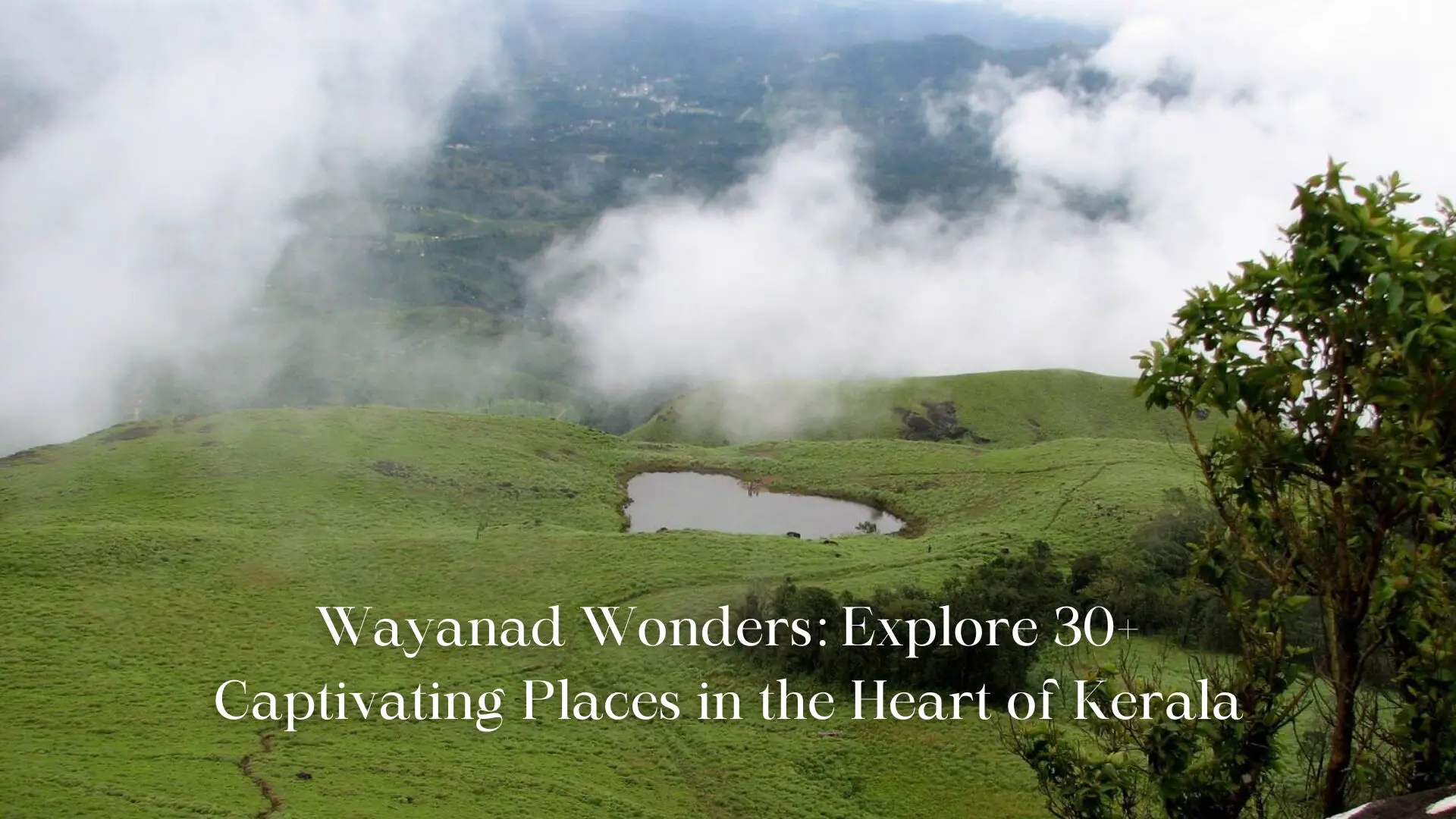Nestled in the lap of Kerala’s Western Ghats, Wayanad District is a haven for nature lovers, adventure seekers, and those yearning for cultural richness. With its lush greenery, mist-covered hills, and a myriad of attractions, Wayanad unfolds as a treasure trove of diverse experiences. Join us on a virtual tour as we explore over 30 captivating places that make Wayanad an enchanting destination.
Banasura Dam: A Serene Retreat Amidst Nature’s Majesty
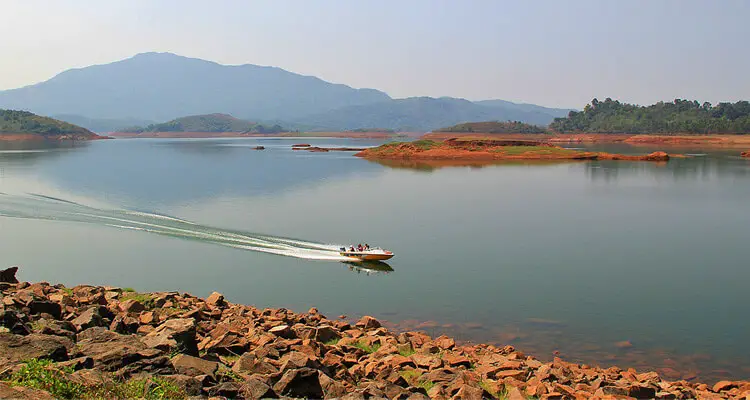
Nestled in the picturesque landscapes of Wayanad, Kerala, Banasura Dam stands as a testament to the region’s natural beauty and engineering marvels. As the largest earth dam in India and the second-largest in Asia, Banasura Dam offers visitors a tranquil retreat surrounded by lush greenery and the captivating Western Ghats.
Scenic Beauty:
One of the primary draws of Banasura Dam is its breathtaking surroundings. The reservoir, formed by the dam across the Karamanathodu River, creates a serene lake against the backdrop of mist-covered hills. The lush greenery and the pristine waters make it an ideal spot for nature lovers seeking a peaceful escape.
Boating Experience:
Visitors can engage in a delightful boating experience on the Banasura Sagar Dam. The boathouse near the dam offers pedal boats and rowboats, allowing guests to leisurely explore the tranquil waters while taking in the panoramic views of the surrounding hills. The experience is not only refreshing but also provides a unique perspective of the dam’s vast expanse.
Banasura Island:
The dam’s reservoir forms the Banasura Island, an enchanting spot accessible by boat. The island offers a serene escape, surrounded by the calm waters of the reservoir. Visitors can explore the island, relax in the shade of the trees, and enjoy a peaceful picnic against the backdrop of Wayanad’s natural beauty.
Adventure Activities:
Banasura Dam caters to adventure enthusiasts as well. The hills surrounding the dam offer opportunities for trekking, providing panoramic views of the Western Ghats and the sprawling dam below. The trek to Banasura Peak is particularly popular, offering a rewarding experience for those seeking a bit of adventure during their visit.
Cultural Significance:
Apart from its natural allure, Banasura Dam also holds cultural significance. The dam derives its name from Banasura, a mythical character in Hindu mythology. According to legend, Banasura, the son of King Mahabali, chose this region for his abode, adding a touch of mystique to the dam’s surroundings.
Edakkal Caves: Unveiling Ancient Mysteries Amidst Wayanad’s Splendor
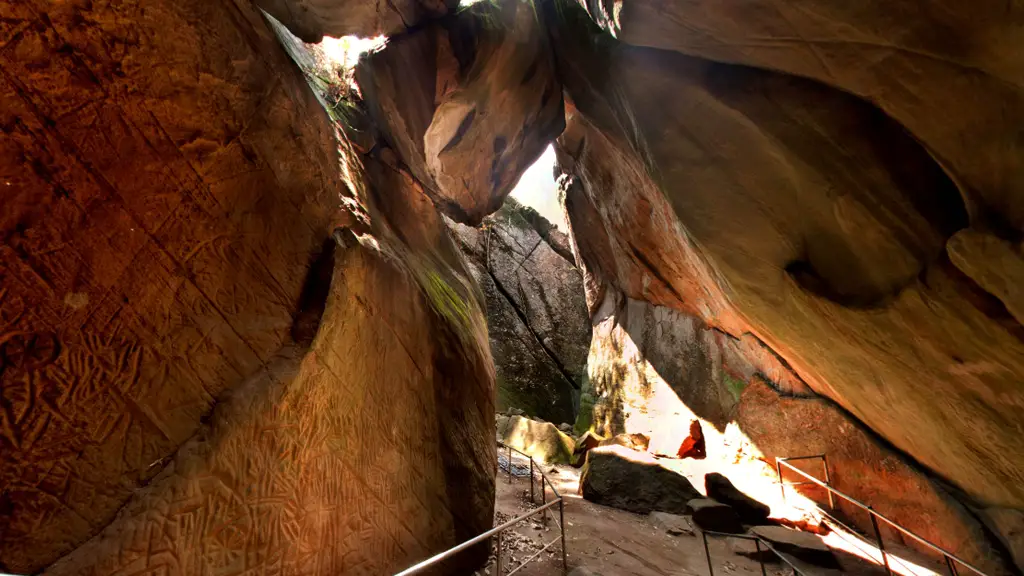
Nestled in the captivating landscapes of Wayanad, Kerala, Edakkal Caves stand as an archaeological marvel, offering visitors a unique journey into the past. Carved into the Ambukuthi Hills, these ancient caves hold a treasure trove of history, art, and natural beauty, making them a must-visit destination for those seeking an enriching and awe-inspiring experience.
Historical Significance:
Edakkal Caves, often referred to as the “Stone Age Edakkal,” boast carvings and inscriptions that date back over 5,000 years. The caves provide a fascinating glimpse into the lives of the Neolithic people who once inhabited this region. The carvings depict scenes of daily life, rituals, and various symbols, offering a unique window into the ancient world.
The Journey to the Caves:
The journey to Edakkal Caves itself is an adventure. A scenic trek through picturesque landscapes and lush greenery leads to the entrance of the caves. The approximately 1.5-kilometer trek is not just a physical journey but a sensory experience, with the sounds of nature and the crisp mountain air creating an immersive ambiance.
Cave Entrances and Ambiance:
The caves are actually two large chambers that have been formed by a large split rock. The entrance to the first chamber is relatively straightforward, but to access the second chamber, visitors need to navigate a set of stone steps and a small passage. The interiors of the caves are cool and dimly lit, adding to the mystique of the ancient carvings.
Ancient Inscriptions:
As visitors explore the caves, they come across a gallery of ancient inscriptions and petroglyphs that adorn the rock surfaces. The carvings depict figures of human and animal forms, symbols, and scenes from daily life, providing archaeologists and history enthusiasts with valuable insights into the cultural practices and beliefs of the ancient inhabitants.
Panoramic Views from the Top:
Upon reaching the top of the caves, visitors are rewarded with panoramic views of the Wayanad region. The breathtaking landscapes, encompassing the Western Ghats and the lush greenery below, offer a spectacular backdrop to the historical richness of the site.
Preservation and Cultural Significance:
Efforts are underway to preserve Edakkal Caves and its invaluable cultural heritage. The Archaeological Survey of India has played a crucial role in maintaining the site’s integrity while allowing visitors to marvel at its ancient wonders.
Chembra Peak Trek: A Majestic Odyssey in the Heart of Wayanad
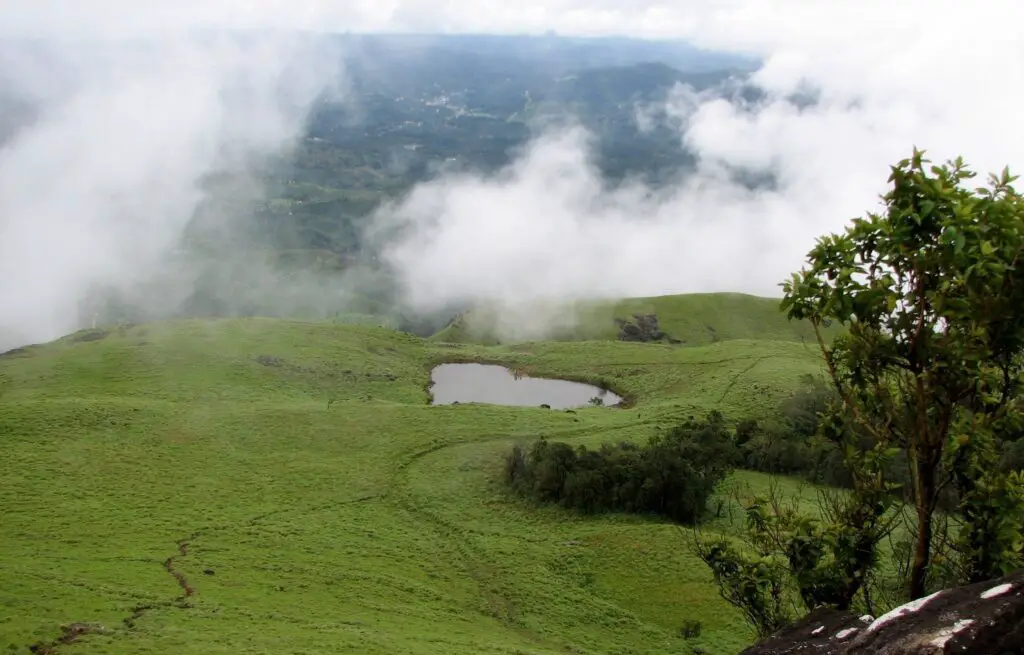
Nestled in the scenic landscapes of Wayanad, the trek to Chembra Peak stands as a thrilling adventure, offering trekkers a chance to conquer the highest summit in the region. Surrounded by lush greenery, diverse flora, and captivating vistas, this trek is not just a physical challenge but a journey into the heart of Wayanad’s natural splendor.
The Journey Begins:
Embarking on the Chembra Peak trek is like entering a realm of untouched beauty. The trek begins at the foothills of the Western Ghats, where trekkers are welcomed by the refreshing sight of tea plantations and the distant mist-covered hills. The trail winds through dense forests, presenting a picturesque ascent that gradually unveils the grandeur of the peak.
Heart Lake Enchantment:
One of the trek’s highlights is the heart-shaped lake, known as “Hridaya Saras” or Heart Lake, situated near the summit. The lake is a natural reservoir and a sight to behold, captivating trekkers with its serene beauty against the backdrop of the rugged mountain terrain. The heart-shaped formation adds a touch of romance to the adventure, making it a popular spot for trekkers to pause, reflect, and capture the moment.
Ascent to the Summit:
The ascent to Chembra Peak demands physical stamina and determination, as the trail becomes steeper, adorned with rocky terrains and a challenging incline. Trekkers traverse through dense shola forests, crossing crystal-clear streams and meadows, all while being accompanied by the soothing sounds of nature. The journey is a sensory delight, with the fragrance of wildflowers and the symphony of birds adding to the overall experience.
Panoramic Views from the Summit:
Upon reaching the summit, trekkers are rewarded with breathtaking panoramic views of Wayanad and its surrounding landscapes. The vast expanse of lush greenery, the undulating hills, and the distant misty peaks create a scene that is both humbling and awe-inspiring. The summit provides a perfect vantage point for trekkers to soak in the natural beauty of Kerala.
Cultural Significance:
Chembra Peak also holds cultural significance, featuring a small shrine dedicated to Karimbil Kunnu Muthappan, a local deity believed to guard the mountain. Trekkers often pay their respects at the shrine before beginning their descent.
Conservation and Responsible Trekking:
As Chembra Peak is part of the Wayanad Wildlife Sanctuary, it’s crucial for trekkers to adhere to responsible trekking practices. The trail is regulated by forest officials to ensure the conservation of the fragile ecosystem. Trekkers are encouraged to respect nature, avoid littering, and follow designated paths to minimize their environmental impact.
Pookode Lake Boat Ride: Serenity Afloat in Wayanad’s Gem
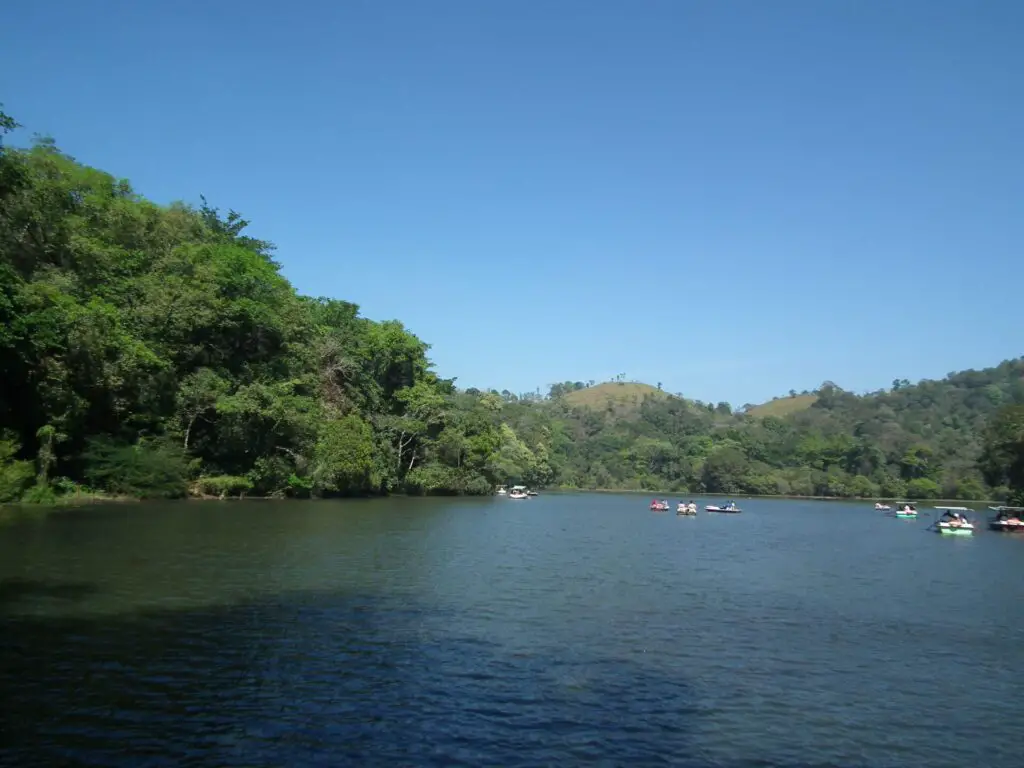
Tucked away amidst the lush landscapes of Wayanad, Pookode Lake is a pristine natural reservoir that invites visitors to embark on a leisurely boat ride, revealing the serene beauty of Kerala’s hill district. The boat ride across Pookode Lake is more than just a tranquil experience; it’s an immersion into the tranquil heart of nature, surrounded by dense forests, vibrant flora, and a refreshing ambiance.
Boating amidst Scenic Bliss:
The Pookode Lake boat ride promises a delightful journey across crystal-clear waters, with the majestic Western Ghats serving as a scenic backdrop. Visitors can choose from paddleboats, rowboats, and pedal boats, each offering a unique perspective of the lake’s breathtaking surroundings. The tranquil waters reflect the lush greenery, creating a mesmerizing tableau that captivates every traveler on board.
Flora and Fauna Encounter:
As the boat gently glides over the lake’s surface, passengers are treated to a close-up view of the abundant flora and fauna that call Pookode Lake home. The lake is surrounded by thick forests, creating a haven for various bird species. Birdwatchers can delight in spotting vibrant kingfishers, elegant egrets, and other avian residents, adding a touch of natural symphony to the boat ride.
Heart-Shaped Lake Island:
One of the distinctive features of Pookode Lake is the small freshwater island at its center. Shaped like a heart, this island enhances the lake’s charm and has become a symbol of romance for those visiting the area. The boat ride offers a unique opportunity to admire this heart-shaped island, creating a picturesque moment that often becomes a highlight of the experience.
Tranquil Escape:
Pookode Lake, enveloped by dense greenery and the tranquil ambiance of Wayanad, provides a perfect escape from the hustle and bustle of everyday life. The gentle swaying of the boat, the soothing sounds of nature, and the crisp mountain air combine to create an atmosphere of pure relaxation. The boat ride becomes not just a journey across the lake but a rejuvenating experience for the mind and soul.
Accessibility and Amenities:
Situated near Vythiri, Pookode Lake is easily accessible, making it a popular destination for both locals and tourists. The site is well-maintained, with facilities for boat rentals, ensuring that visitors can seamlessly enjoy the calming boat ride experience. The surrounding area also features a pristine walking path, allowing visitors to explore the lake’s periphery on foot.
Muthanga Wildlife Sanctuary: A Safari into the Heart of Wayanad’s Biodiversity

Nestled in the picturesque landscapes of Wayanad, Muthanga Wildlife Sanctuary beckons wildlife enthusiasts and nature lovers to embark on an immersive safari adventure. Spanning over 344 square kilometers, this sanctuary is a haven for biodiversity, featuring diverse flora and fauna that make it a must-visit destination for those seeking a close encounter with the wild side of Kerala.
Biodiversity Extravaganza:
Muthanga Wildlife Sanctuary, also known as Wayanad Wildlife Sanctuary, is celebrated for its rich biodiversity. The sanctuary is home to a plethora of wildlife species, including elephants, deer, langurs, tigers, leopards, and a variety of exotic birds. The diverse habitats within the sanctuary, ranging from moist deciduous forests to grasslands, create an ideal environment for different species to thrive.
Safari Experience:
The highlight of a visit to Muthanga Wildlife Sanctuary is undoubtedly the safari experience. Visitors can explore the sanctuary’s vast expanse aboard safari vehicles accompanied by knowledgeable guides. The safari takes guests deep into the heart of the sanctuary, providing opportunities to spot various wildlife species in their natural habitats. The excitement of encountering elephants or witnessing the elusive big cats in the wild adds an element of thrill to the safari.
Rich Avian Life:
For bird enthusiasts, Muthanga Wildlife Sanctuary is a paradise. The sanctuary is home to a diverse avian population, with over 200 species of birds recorded. During the safari, birdwatchers can catch glimpses of vibrant species such as the Malabar grey hornbill, Indian peafowl, and various eagles, making it a birding haven amidst the lush greenery.
Floral Diversity:
Apart from its charismatic wildlife, Muthanga Sanctuary boasts a rich array of plant species. The landscape is adorned with towering trees, flowering plants, and dense undergrowth, creating a vibrant tapestry of colors. The diverse vegetation enhances the overall biodiversity of the sanctuary, contributing to the well-balanced ecosystem that supports its varied wildlife.
Community Involvement:
Muthanga Wildlife Sanctuary actively involves local communities in its conservation efforts. The tribal communities residing in the fringes of the sanctuary coexist harmoniously with the wildlife. The Forest Department collaborates with these communities to promote sustainable practices, ensuring that the sanctuary remains a thriving ecosystem for generations to come.
Visitor Guidelines and Responsible Tourism:
To ensure the conservation of the sanctuary’s delicate ecosystem, visitors are encouraged to adhere to responsible tourism practices. Safari regulations are in place to minimize disturbances to the wildlife, and visitors are urged to follow guidelines set by the Forest Department, including maintaining a safe distance from the animals.
Wayanad Heritage Museum: Unraveling the Tapestry of Wayanad’s Past
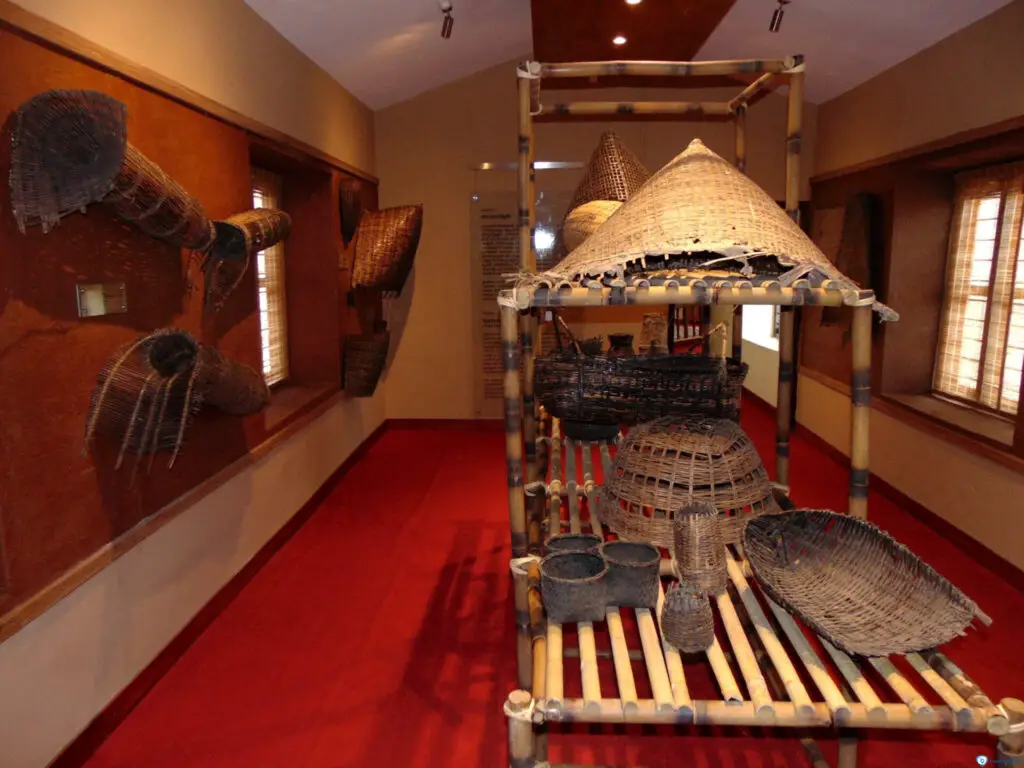
Nestled in the verdant hills of Wayanad, the Wayanad Heritage Museum stands as a guardian of the region’s rich cultural history. This museum, also known as the Ambalavayal Heritage Museum, offers visitors a captivating journey through time, allowing them to unravel the intricate threads of Wayanad’s past, from ancient artifacts to tribal traditions.
Preserving Cultural Treasures:
The Wayanad Heritage Museum is a treasure trove of artifacts that spans various periods of Wayanad’s history. It serves as a custodian of the cultural and historical heritage of the region, showcasing artifacts that highlight the evolution of Wayanad from ancient times to the present day. The museum is an essential destination for history enthusiasts, anthropologists, and curious travelers eager to explore the roots of Kerala’s cultural tapestry.
Ancient Artifacts and Tools:
The museum’s exhibits include a fascinating collection of artifacts, showcasing tools, pottery, and utensils that offer insights into the daily lives of the ancient inhabitants of Wayanad. Stone-age tools, prehistoric artifacts, and ancient pottery provide a glimpse into the technological and artistic achievements of early communities that once thrived in this region.
Tribal Art and Culture:
Wayanad is home to several indigenous tribal communities, and the museum pays homage to their rich cultural heritage. Visitors can explore exhibits that shed light on the unique customs, rituals, and traditional art forms of the tribes that have called Wayanad home for generations. Intricately crafted tribal artifacts and tools offer a deeper understanding of the region’s cultural diversity.
Edakkal Caves Connection:
The museum also holds a special connection with the nearby Edakkal Caves, as it houses artifacts unearthed during archaeological excavations in and around the caves. These artifacts, including ancient rock carvings, provide a bridge between the museum and the fascinating prehistoric wonders of Edakkal.
Photographic Archives:
In addition to physical artifacts, the museum boasts an extensive photographic archive that captures the transformation of Wayanad over the years. Vintage photographs and historical images narrate the stories of the people, landscapes, and cultural events that have shaped the region.
Interactive Exhibits:
The Wayanad Heritage Museum embraces modernity with interactive exhibits that engage visitors in a dynamic learning experience. Multimedia presentations, audio guides, and informative displays enhance the overall museum experience, making it educational and enjoyable for visitors of all ages.
Conservation and Cultural Outreach:
The museum actively participates in cultural conservation efforts, collaborating with local communities to preserve and promote traditional practices. Special events, workshops, and cultural programs organized by the museum contribute to the cultural outreach, fostering a sense of pride and appreciation for Wayanad’s heritage among both locals and tourists.
Meenmutty Falls Trek: A Cascading Odyssey through Wayanad’s Wilderness
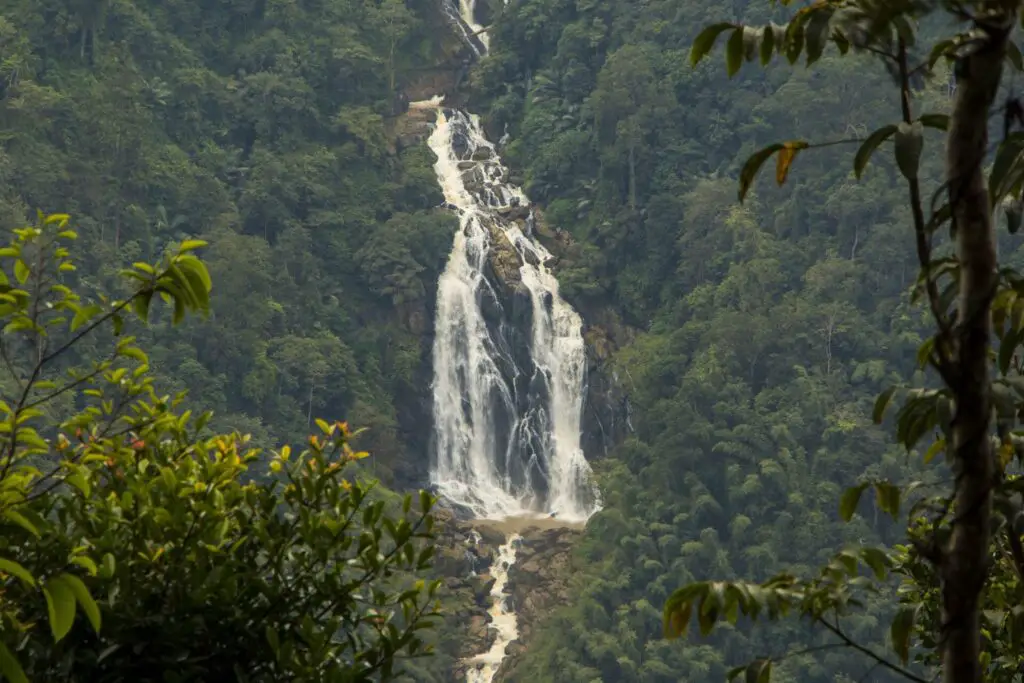
Nestled in the lush landscapes of Wayanad, the Meenmutty Falls trek stands as a testament to nature’s grandeur. This exhilarating trek leads adventurers through dense forests, across babbling streams, and finally unveils the breathtaking beauty of Meenmutty Falls—a cascading spectacle that epitomizes the untamed allure of Kerala’s Western Ghats.
Trailhead Amidst Nature’s Embrace:
The Meenmutty Falls trek begins in the heart of Wayanad, at the trailhead near the picturesque Banasura Sagar Dam. Trekkers are immediately immersed in nature’s embrace as they traverse through dense foliage and vibrant plant life, providing a preview of the natural wonders that await on the journey.
Traversing Forested Trails:
The trek takes adventurers on a winding path through dense forests, where the air is filled with the symphony of rustling leaves and melodious birdcalls. The canopy of trees provides a refreshing shade, creating a cool and tranquil atmosphere that complements the rhythmic cadence of the trek.
Streams and Water Crossings:
As trekkers progress, they encounter streams and small water crossings that add an element of adventure to the journey. Balancing on rocks and navigating through the crystal-clear waters of these streams become integral parts of the Meenmutty Falls trek, offering trekkers a chance to interact with the natural elements along the way.
Ascending to the Spectacular Falls:
The real spectacle awaits at the culmination of the trek—the majestic Meenmutty Falls. Cascading down in three tiers with a total height of around 300 meters, the falls present a breathtaking panorama. The trek concludes with trekkers reaching a vantage point that offers mesmerizing views of Meenmutty Falls in all its glory, surrounded by the lush greenery of the Western Ghats.
Photographic Paradise:
Meenmutty Falls provides a visual feast for photography enthusiasts. The interplay of sunlight filtering through the foliage, the misty spray from the falls, and the vibrant hues of the surrounding flora create a photographic paradise. Trekkers are encouraged to capture the essence of the trek, preserving the memories of this captivating journey.
Responsible Trekking:
To ensure the preservation of the natural ecosystem, responsible trekking practices are crucial during the Meenmutty Falls trek. Trekkers are advised to follow designated trails, avoid littering, and adhere to guidelines set by local authorities to minimize the impact on the fragile environment.
Thirunelli Temple: A Spiritual Odyssey in the Heart of Wayanad

Nestled amidst the verdant landscapes of Wayanad, the Thirunelli Temple stands as a sacred haven, inviting pilgrims and seekers of spiritual solace to embark on a journey of divine exploration. With its ancient history, serene ambiance, and lush surroundings, a visit to Thirunelli Temple is not just a religious sojourn but a cultural and spiritual odyssey through the heart of Kerala.
Ancient Roots and Legends:
Thirunelli Temple, dedicated to Lord Vishnu in the form of Chaturbhuja, holds an ancient legacy that dates back centuries. According to local legends, the temple was consecrated by Lord Brahma himself, making it a revered pilgrimage site. The temple is nestled in the Brahmagiri Hills, surrounded by dense forests and pristine nature, creating a tranquil setting that complements its sacred aura.
Architectural Splendor:
The architecture of Thirunelli Temple reflects the classical Kerala style, with its traditional wooden carvings, sloping roofs, and intricate details that pay homage to the region’s cultural heritage. The temple’s sanctum sanctorum houses the deity in the Chaturbhuja form, an awe-inspiring representation that captivates devotees and visitors alike.
Panchatheertham: The Sacred Pond:
One of the unique features of Thirunelli Temple is the Panchatheertham, a sacred pond fed by five mountain springs. Pilgrims believe that a dip in these holy waters cleanses the soul of impurities and brings spiritual purification. Surrounded by lush greenery, the Panchatheertham adds to the overall serene ambiance of the temple complex.
A Gateway to Moksha:
Thirunelli Temple is renowned as the “Gateway to Moksha” (salvation), and pilgrims often visit to perform rituals for their ancestors, seeking divine blessings and liberation from the cycle of rebirth. The temple is an essential destination during rituals such as Pithru Tharpanam, attracting devotees who come to honor their forefathers.
Surrounded by Natural Beauty:
Beyond its spiritual significance, Thirunelli Temple is embraced by the breathtaking beauty of the Western Ghats. The temple complex is surrounded by lush forests, mist-covered hills, and the tranquil Papanasini River, creating an idyllic backdrop that enhances the spiritual experience. The divine and the natural coexist harmoniously in this sacred sanctuary.
Wayanad’s Cultural Melting Pot:
Thirunelli Temple is not just a place of worship but a cultural melting pot where various rituals, festivals, and ceremonies bring the community together. The temple’s annual festival, known as “Thirunelli Utsavam,” attracts devotees and tourists alike, showcasing the vibrant traditions of Kerala.
Accessibility and Responsible Tourism:
Thirunelli Temple is easily accessible, making it a significant pilgrimage site in Wayanad. Visitors are encouraged to adhere to responsible tourism practices, respecting the sanctity of the temple and the natural surroundings. Modest attire is advised, and footwear is not allowed within the temple premises.
Karapuzha Dam: A Tranquil Reservoir Amidst Wayanad’s Splendor
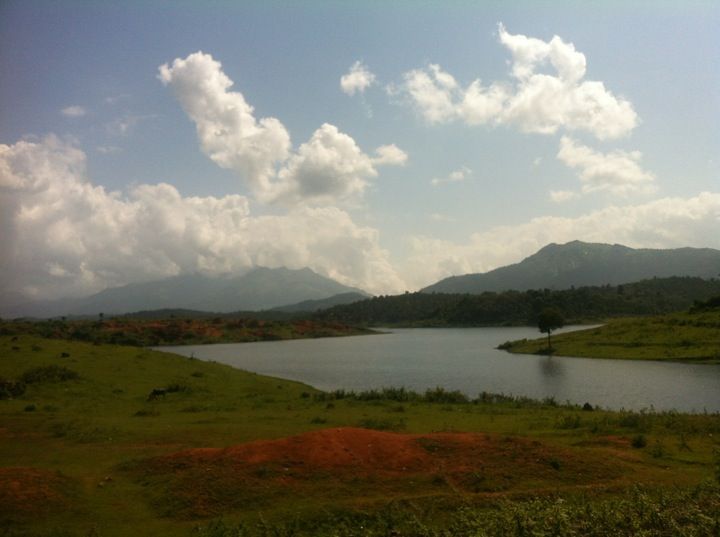
Tucked away in the picturesque landscapes of Wayanad, the Karapuzha Dam stands as a serene reservoir, inviting visitors to a tranquil escape amidst nature’s grandeur. This scenic destination, embraced by the Western Ghats, not only serves as a vital water resource but also offers a captivating setting for those seeking moments of tranquility and natural beauty.
Scenic Beauty Amidst Hills:
Karapuzha Dam is nestled in the embrace of the Western Ghats, creating a mesmerizing backdrop that complements the reservoir’s tranquility. Surrounded by undulating hills draped in lush greenery, the dam offers panoramic views that captivate the hearts of those who venture to its shores.
Boating on the Reservoir:
A visit to Karapuzha Dam provides the opportunity for a leisurely boat ride on the reservoir’s calm waters. Boating enthusiasts can embark on a journey that unfolds the scenic beauty of the dam and its surroundings. The boat ride allows visitors to witness the hills mirrored in the clear waters, creating a serene and reflective ambiance.
Picnic Spots and Relaxation:
The expansive reservoir banks of Karapuzha Dam offer ideal picnic spots for families and friends. Shaded areas with lush grass provide a perfect setting for a leisurely picnic, where visitors can unwind amidst the soothing sounds of nature. The dam’s tranquil environment makes it an ideal retreat for relaxation and rejuvenation.
Birdwatching Paradise:
Karapuzha Dam’s surroundings are a haven for birdwatchers. The reservoir attracts a variety of bird species, making it a paradise for those interested in avian diversity. From vibrant kingfishers to majestic eagles, the dam’s ecosystem fosters a rich environment for birdwatching enthusiasts.
Photographic Delight:
The scenic beauty of Karapuzha Dam offers numerous opportunities for photographers to capture the essence of Wayanad’s natural charm. Whether it’s the reflections on the reservoir, the surrounding hills, or the vibrant birdlife, every corner of the dam presents a visual feast for those with a keen eye for photography.
Cultural Significance:
Apart from its natural allure, Karapuzha Dam holds cultural significance in the region. The dam and its reservoir are integral to the local agricultural landscape, serving as a vital water source for the surrounding areas. The dam plays a crucial role in sustaining the agricultural practices and livelihoods of the communities in Wayanad.
Accessibility and Responsible Tourism:
Karapuzha Dam is easily accessible, making it a popular destination for both locals and tourists. Responsible tourism practices are encouraged, including the proper disposal of waste and the preservation of the dam’s natural surroundings. Visitors are advised to respect the tranquility of the area and adhere to guidelines set by local authorities.
Soochipara Waterfalls: A Majestic Cascade Amidst Wayanad’s Wilderness
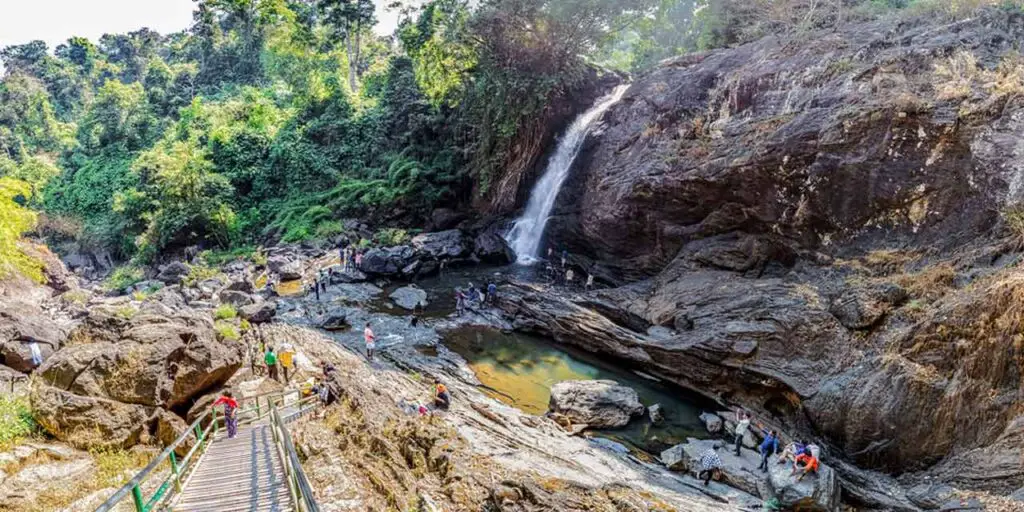
Nestled in the heart of Wayanad’s lush landscapes, Soochipara Waterfalls, also known as Sentinel Rock Waterfalls, beckon nature enthusiasts and adventure seekers alike. This majestic cascade, surrounded by dense forests and pristine nature, offers a thrilling escape into the wild beauty of Kerala’s Western Ghats.
The Journey to Soochipara:
The adventure to Soochipara Waterfalls begins with a scenic drive through the winding roads of Wayanad, surrounded by tea estates and verdant hills. Upon reaching the entrance, visitors embark on a trek through the dense forests, creating an anticipation that builds with each step.
Trek through Nature’s Canvas:
The trek to Soochipara Waterfalls is an integral part of the experience. As trekkers navigate through the dense foliage, the symphony of birds and the rustling leaves create an immersive ambiance. The trail meanders through the Western Ghats, offering glimpses of the rich biodiversity that thrives in this region.
The Three-Tiered Spectacle:
The highlight of the journey is the breathtaking sight of Soochipara Waterfalls. Cascading down in three tiers from a height of around 200 meters, the falls present a mesmerizing spectacle. The cool mist and the roar of the falls add to the sensory experience, making it a truly awe-inspiring moment for visitors.
Natural Infinity Pool:
At the base of Soochipara Waterfalls lies a natural infinity pool formed by the cascading waters. Adventurous souls can take a refreshing dip in the pool, surrounded by the misty atmosphere and the verdant cliffs. The natural pool is a perfect spot to unwind and relish the embrace of nature.
Rock Climbing and Adventure Activities:
For those seeking an extra dose of adrenaline, Soochipara Waterfalls offers opportunities for rock climbing and other adventure activities. The rocky terrain and the lush surroundings create an ideal setting for adventure enthusiasts to test their skills against the backdrop of the cascading falls.
Photographic Bliss:
Soochipara Waterfalls provides a haven for photographers. From the trek through the dense forests to the majestic sight of the falls, every moment is a frame-worthy capture. The lush greenery, the glistening waters, and the sheer magnitude of the falls offer endless photographic possibilities.
Responsible Tourism:
As a responsible traveler, it’s crucial to respect the natural environment. Visitors to Soochipara Waterfalls are encouraged to follow designated trails, avoid littering, and adhere to guidelines set by local authorities to preserve the delicate ecosystem. Responsible tourism ensures that this natural wonder remains a pristine sanctuary for future generations.
Bamboo Rafting in Kuruva Island: Navigating Nature’s Symphony
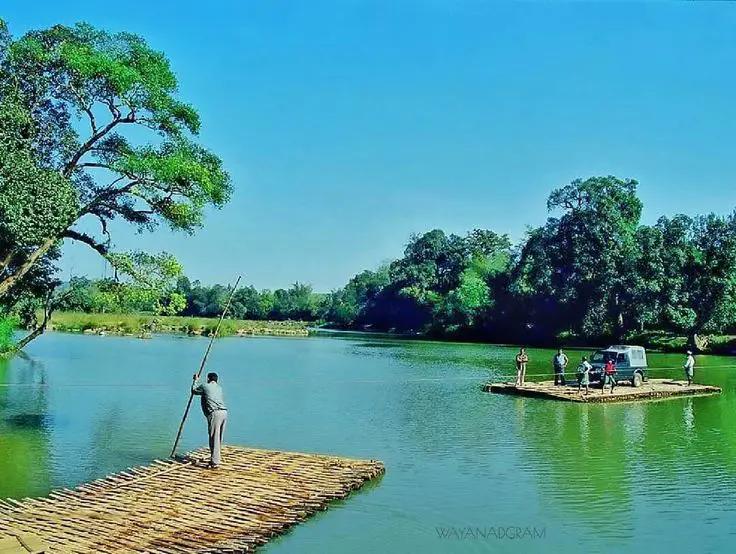
Nestled amidst the serene landscapes of Wayanad, Kuruva Island offers a unique bamboo rafting experience that transcends the ordinary. The tranquil waters, lush greenery, and the soothing sounds of nature come together to create an immersive journey, making bamboo rafting in Kuruva Island a must-try adventure for nature enthusiasts and those seeking a peaceful escape.
Embarking on the Bamboo Raft:
The bamboo rafting adventure at Kuruva Island begins with a gentle glide onto the pristine river waters that surround this verdant oasis. The rafts, crafted from sturdy bamboo poles, provide a sustainable and eco-friendly mode of transportation, allowing visitors to explore the island’s natural beauty in harmony with the environment.
Traversing the Meandering Rivers:
As the bamboo raft drifts along the meandering rivers that crisscross Kuruva Island, the enchanting melody of nature becomes the soundtrack of the journey. The soothing rustle of leaves, the calls of exotic birds, and the gentle flow of the river create a symphony that elevates the entire bamboo rafting experience.
Rich Biodiversity and Flora:
Kuruva Island is renowned for its rich biodiversity, and bamboo rafting offers a unique vantage point to appreciate the island’s natural treasures. The rafts navigate through dense forests and over the crystal-clear waters, providing glimpses of vibrant flora and the diverse ecosystems that thrive along the riverbanks.
Birdwatcher’s Paradise:
For avid birdwatchers, bamboo rafting in Kuruva Island presents an unrivaled opportunity to spot a variety of avian species. The island is home to a multitude of birds, including kingfishers, woodpeckers, and colorful butterflies. The slow and unobtrusive movement of the bamboo rafts allows enthusiasts to observe these winged wonders in their natural habitat.
Picnic Spots and Riverside Relaxation:
The bamboo rafting journey includes stops at designated spots along the riverbanks, where visitors can disembark and enjoy picnics amidst the lush greenery. These idyllic locations offer a chance to relax, savor the beauty of the surroundings, and indulge in a tranquil riverside experience.
Environmental Conservation:
Kuruva Island places a strong emphasis on environmental conservation, and bamboo rafting aligns with this commitment. The use of bamboo, a sustainable and renewable resource, ensures that the rafting experience is eco-friendly and minimizes the impact on the delicate island ecosystem.
Safety Measures and Guided Tours:
To ensure a safe and enjoyable experience, bamboo rafting in Kuruva Island is often conducted under the guidance of skilled local guides. These guides not only navigate the rafts but also share insights about the island’s ecology, cultural significance, and the importance of preserving its natural beauty.
Wayanad Tea Plantations: Sipping Tranquility in Nature’s Cup

Nestled in the lap of the Western Ghats, Wayanad’s tea plantations stand as emerald-green carpets cascading down the hills, creating a landscape of serenity and sensory delight. Exploring the tea estates of Wayanad is not just a journey into the heart of Kerala’s verdant hills but a sensorial odyssey through the aromatic world of tea.
Cultivation Amidst the Hills:
Wayanad’s tea plantations thrive in the cool and misty climate of the Western Ghats, creating an ideal environment for tea cultivation. The undulating hills, with their terraced slopes, offer the perfect canvas for the orderly rows of tea bushes that characterize the landscape. The tea estates are a testament to the harmonious coexistence of agriculture and nature in this picturesque region.
Tea Varieties of Wayanad:
Wayanad’s tea plantations boast a variety of tea cultivars, each contributing to the diverse flavors and aromas produced in the region. From the robustness of Assam tea to the delicate notes of Darjeeling tea, Wayanad’s tea gardens cater to the preferences of tea connoisseurs seeking a nuanced experience with every sip.
Guided Tours and Tea Tastings:
Visitors to Wayanad’s tea plantations have the opportunity to embark on guided tours that unravel the secrets of tea cultivation. Knowledgeable guides lead guests through the emerald fields, explaining the tea-making process from plucking to processing. The tours often culminate in tea tastings, allowing visitors to savor the distinct flavors of Wayanad’s homegrown teas.
Picturesque Landscapes and Photography:
The tea estates of Wayanad paint a picturesque panorama that captivates the eyes and the lens. Photographers find themselves drawn to the symmetrical patterns of tea bushes, the interplay of light and shadow, and the mist-kissed hills that create scenes worthy of postcards. The ever-changing weather adds an enchanting dimension to the visual narrative of the tea plantations.
Cultural Interactions with Tea Workers:
Behind the scenic beauty of Wayanad’s tea plantations lies the labor and dedication of the tea workers who tend to the bushes. Visitors have the chance to engage with the local communities, gaining insights into the cultural tapestry woven by those whose hands nurture the tea leaves. These interactions add a human touch to the tea plantation experience.
Nature Walks amidst Tea Gardens:
Many tea estates in Wayanad offer nature walks that wind through the tea gardens, providing a sensory immersion into the sights, sounds, and fragrances of the plantations. The rustling leaves, the gentle breeze, and the aroma of tea leaves infuse the air, creating an atmosphere of tranquility that accompanies every step.
Environmental Sustainability:
Wayanad’s tea plantations often prioritize environmental sustainability, implementing eco-friendly practices in cultivation. From organic farming methods to water conservation initiatives, these plantations showcase a commitment to preserving the natural beauty and biodiversity of the region.
Wayanad Adventure Camp: A Thrilling Odyssey in Nature’s Playground
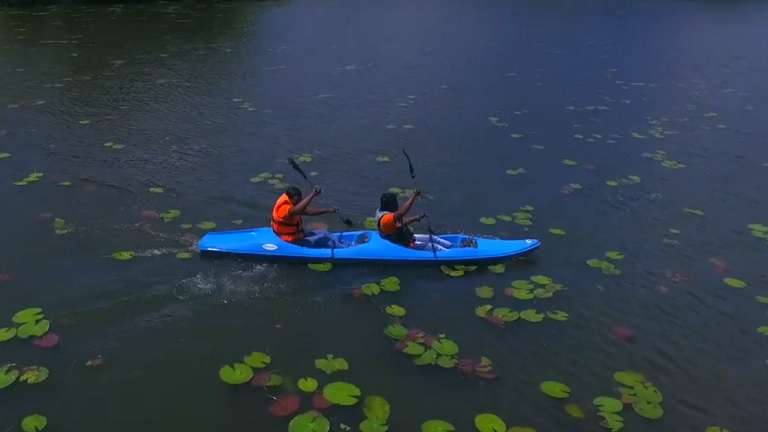
Nestled in the verdant embrace of Wayanad’s Western Ghats, the Wayanad Adventure Camp stands as a gateway to exhilarating escapades amidst nature’s playground. For thrill-seekers and nature enthusiasts, this camp offers a kaleidoscope of outdoor adventures, creating an immersive experience that harmonizes with the pristine beauty of Kerala’s hill district.
Camping Amidst Nature’s Symphony:
The Wayanad Adventure Camp welcomes adventurers to a canvas of lush landscapes, where camping becomes a rendezvous with nature. Tucked away from the hustle and bustle, the campsite offers a tranquil escape, with the soothing sounds of rustling leaves and chirping birds providing a melodic backdrop to the camping experience.
Trekking Expeditions:
Wayanad’s undulating terrain and pristine forests set the stage for exhilarating trekking expeditions. The adventure camp organizes guided treks that lead participants through dense foliage, revealing panoramic vistas, hidden waterfalls, and the diverse flora and fauna that characterize the Western Ghats. Trekking enthusiasts find themselves immersed in the raw beauty of Wayanad’s wilderness.
Ziplining through Canopy Canvases:
For those seeking an adrenaline rush, ziplining amidst the canopy of Wayanad’s forests is a must-try adventure. The Wayanad Adventure Camp boasts thrilling zipline courses that offer breathtaking aerial views of the landscape below. Participants soar through the treetops, experiencing the sheer thrill of traversing the forest canopy.
Rock Climbing and Rappelling Challenges:
Wayanad’s rugged terrains provide a natural setting for rock climbing and rappelling challenges. The adventure camp features rock faces that beckon enthusiasts to test their climbing skills, with trained guides ensuring a safe yet thrilling ascent. Rappelling down sheer cliffs adds an extra layer of excitement to the adventure experience.
River Rafting on Kabini:
The nearby Kabini River presents an opportunity for water-based adventures, and the Wayanad Adventure Camp takes full advantage. River rafting expeditions down the Kabini offer a wet and wild ride, with participants navigating through exciting rapids surrounded by the scenic beauty of Wayanad’s riverine landscapes.
Nature Cycling Trails:
Exploring Wayanad’s natural wonders on two wheels is a rejuvenating experience. The adventure camp organizes nature cycling trails that wind through picturesque plantations, spice gardens, and quiet village paths. Cycling enthusiasts can immerse themselves in the sights and sounds of Wayanad’s rural charm.
Campfire Conversations and Stargazing:
As the sun sets over Wayanad, the adventure camp comes alive with the warm glow of campfires. Participants gather around, sharing stories and experiences under the starlit sky. Stargazing becomes a serene finale to the day, with the clear night skies of Wayanad offering a celestial spectacle.
Environmental Conservation and Responsible Adventure:
The Wayanad Adventure Camp emphasizes responsible adventure tourism. Environmental conservation practices, waste management initiatives, and community engagement programs contribute to the sustainability of the camp’s operations. The goal is to ensure that the thrill of adventure coexists harmoniously with the preservation of Wayanad’s natural beauty.
Thusharagiri Waterfalls: Nature’s Symphony in the Heart of Wayanad
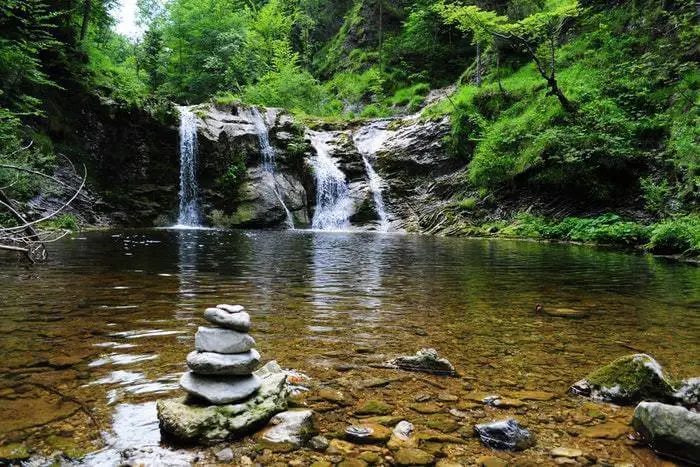
Nestled amidst the verdant landscapes of Wayanad, Thusharagiri Waterfalls stands as a celestial cascade, inviting visitors to witness the breathtaking union of three mesmerizing falls—Erattumukku, Mazhavil Chattom, and Thanni Muthassi. This enchanting destination, cocooned by the Western Ghats, promises a rejuvenating retreat into the heart of Kerala’s pristine wilderness.
Embarking on the Trail:
The journey to Thusharagiri Waterfalls begins with a trek through the lush greenery that blankets the Western Ghats. The trail, shaded by towering trees and resonating with the melodies of native birds, offers a glimpse into the rich biodiversity that thrives in this natural sanctuary. The trek serves as a prelude to the majestic spectacle awaiting at the falls.
Erattumukku Waterfall: The Gentle Beginning
The adventure unfolds with Erattumukku, the first of the three falls at Thusharagiri. Cascading gracefully down a series of rocky steps, this waterfall presents a serene tableau. Visitors can bask in the cool mist and relish the soothing sounds of nature as the gentle waters create a tranquil ambiance.
Mazhavil Chattom Waterfall: The Verdant Veil
Continuing the ascent, Mazhavil Chattom unveils itself as a mesmerizing spectacle. The name, translating to “rainbow pool,” hints at the vivid colors that dance in the mist created by the falls. The cascading waters form a veil of serenity, inviting trekkers to immerse themselves in the ethereal beauty that defines Thusharagiri.
Thanni Muthassi Waterfall: The Roaring Crescendo
The crescendo of Thusharagiri’s symphony is reached at Thanni Muthassi, the final and most powerful waterfall. The thundering waters create an awe-inspiring panorama as they plunge into the natural pool below. The force of Thanni Muthassi reflects the untamed spirit of the Western Ghats, leaving visitors spellbound by its sheer power and beauty.
Natural Pool and Refreshing Dip:
At the base of Thusharagiri Waterfalls lies a serene natural pool, a refreshing oasis inviting tired trekkers to unwind. The crystal-clear waters provide a perfect setting for a rejuvenating dip, surrounded by the lush greenery and the symphony of falling water. The pool offers a moment of tranquility in nature’s embrace.
Birdwatching Extravaganza:
Thusharagiri’s lush environs are a haven for birdwatchers. The diverse flora and serene ambiance attract a myriad of bird species, from colorful kingfishers to elusive hornbills. Visitors can embrace the opportunity to spot and appreciate the rich avian life that thrives in the Western Ghats.
Responsible Tourism and Conservation:
To preserve the pristine beauty of Thusharagiri Waterfalls, responsible tourism practices are encouraged. Visitors are urged to follow designated trails, avoid littering, and respect the delicate ecosystem of the region. Conservation efforts, including tree planting initiatives, contribute to the sustainability of this natural paradise.
Chembra Tea Estate: Savoring Tranquility in Wayanad’s Green Symphony
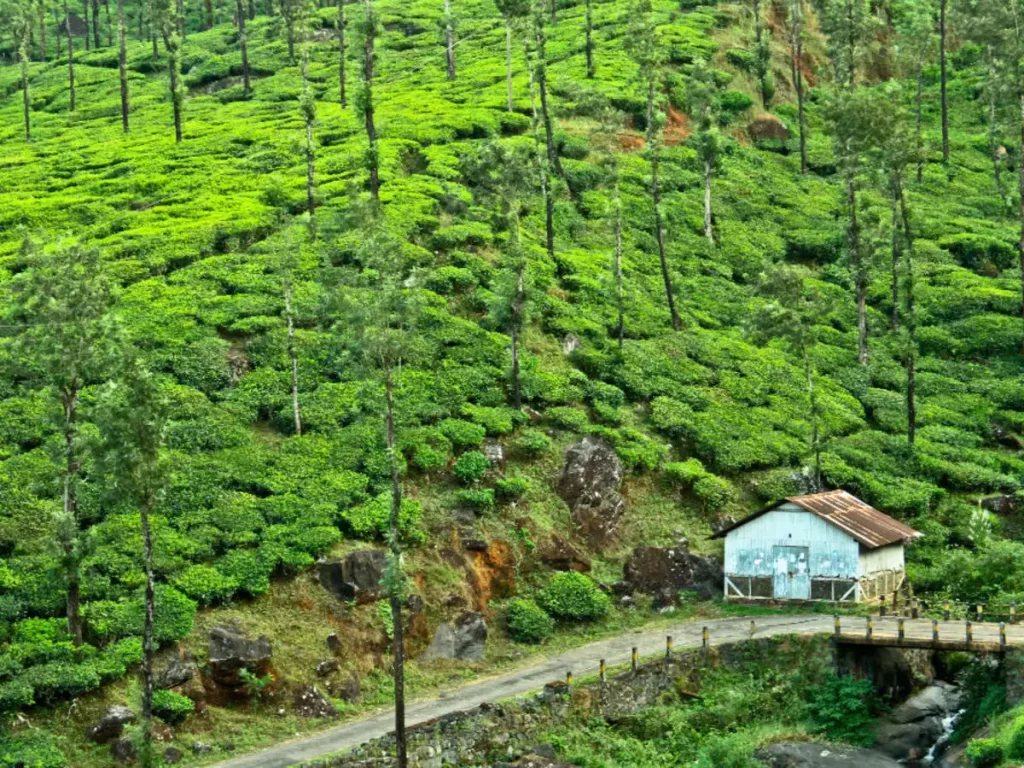
Nestled in the lap of the Western Ghats, Chembra Tea Estate in Wayanad unfolds as a lush expanse of emerald-green plantations, offering a serene retreat for those seeking solace amidst nature’s embrace. This enchanting estate, enveloped by mist-kissed hills, stands as a testament to the artistry of tea cultivation in Kerala’s captivating landscapes.
Cultivating Tranquility:
Chembra Tea Estate captivates visitors with its meticulously manicured tea plantations that cascade down the hillsides. The undulating terrain, punctuated by neatly aligned rows of tea bushes, creates a visual symphony that seamlessly integrates with the natural contours of Wayanad’s terrain. The estate stands as a tranquil canvas, inviting guests to immerse themselves in the tranquility of the surroundings.
Tea Cultivation in the Western Ghats:
The Western Ghats, renowned for their biodiversity, provide an ideal setting for tea cultivation. Chembra Tea Estate takes advantage of this favorable climate and altitude, producing high-quality tea leaves with distinctive flavors. The elevation of the estate contributes to the nuanced taste profiles that characterize Wayanad’s tea.
Guided Tours and Educational Experiences:
Chembra Tea Estate opens its gates to curious visitors, offering guided tours that provide insights into the art and science of tea cultivation. Knowledgeable guides lead guests through the plantations, explaining the various stages of tea production—from plucking the tender leaves to the intricacies of processing that transform them into the aromatic beverage enjoyed worldwide.
Tea Tasting Sessions:
A visit to Chembra Tea Estate is incomplete without indulging in a tea tasting session. Guests have the opportunity to sample a variety of teas produced on the estate, experiencing the distinct notes and aromas that define Wayanad’s tea. From robust black teas to delicate green teas, the tasting session becomes a sensory journey through the diverse world of Chembra’s tea offerings.
Scenic Beauty and Photography:
Chembra Tea Estate’s scenic beauty is a photographer’s delight. The picturesque landscapes, with the tea plantations set against the backdrop of mist-shrouded hills, provide endless opportunities for capturing the essence of Wayanad. The interplay of light and shadow, the vibrant hues of the tea bushes, and the misty ambience create captivating visuals.
Cultural Interactions with Estate Workers:
Behind the scenes of Chembra Tea Estate are the skilled hands of tea workers who tend to the plants with dedication. Visitors often have the chance to engage with the local communities, gaining insights into the cultural richness embedded in the labor that nurtures the tea leaves. These interactions add a human touch to the tea estate experience.
Environmental Conservation and Sustainability:
Chembra Tea Estate is committed to environmental conservation and sustainable practices. Initiatives such as rainwater harvesting, organic farming methods, and waste management contribute to the estate’s goal of preserving the natural beauty of Wayanad and minimizing its ecological footprint.
Banasura Hill Trek: Scaling the Peaks of Wayanad’s Natural Grandeur
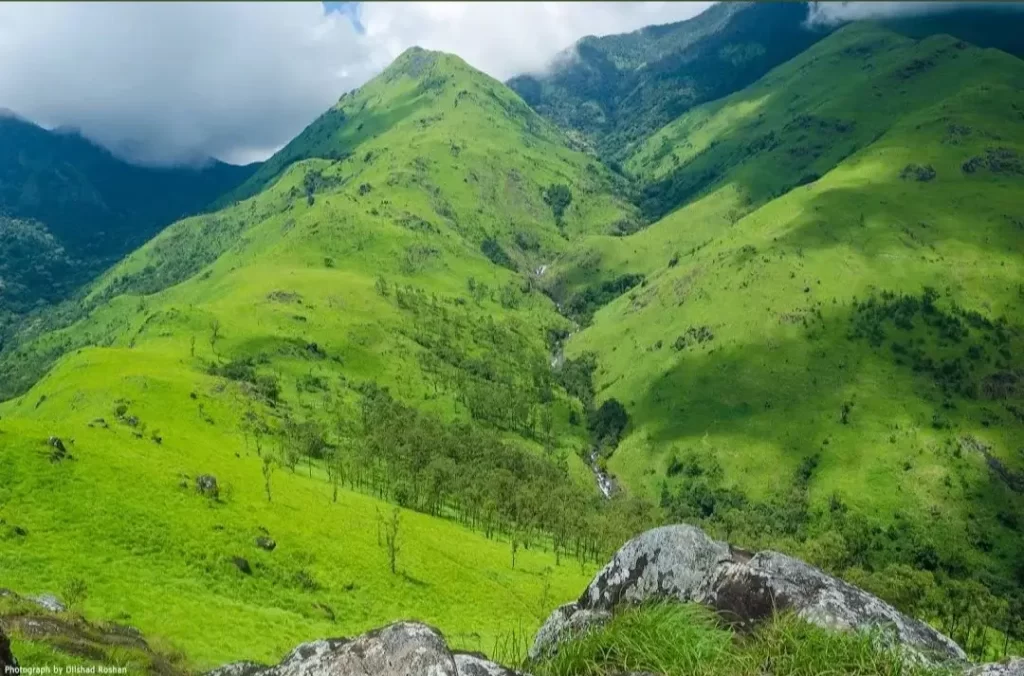
Embarking on the Banasura Hill Trek in Wayanad is an exhilarating journey into the heart of Kerala’s Western Ghats. Offering a perfect blend of adventure and natural beauty, this trek allows hikers to ascend the peaks of Banasura Hills, revealing panoramic vistas, lush landscapes, and the untamed allure of Wayanad’s wilderness.
Trailhead Amidst Nature’s Symphony:
The Banasura Hill Trek begins at the foothills of Banasura, surrounded by the symphony of nature. The trailhead introduces trekkers to the rich biodiversity of the region, with the sounds of chirping birds and rustling leaves accompanying every step. As hikers ascend, the ambiance evolves, offering a preview of the stunning landscapes that await.
Ascending the Peaks:
The trek unfolds as an ascent through dense forests and rocky terrains, with the trail guiding trekkers to higher elevations. Banasura Hills, part of the Western Ghats’ mountain range, provides a challenging yet rewarding terrain for those seeking to conquer its peaks. The gradual climb offers an immersive experience, allowing trekkers to appreciate the diverse flora and fauna along the way.
Banasura Sagar Dam Panorama:
As the trek progresses, a highlight emerges—the panoramic view of Banasura Sagar Dam. Trekkers are rewarded with breathtaking vistas of the sprawling reservoir nestled amidst the hills. The play of sunlight on the water, the lush greenery, and the distant hills create a picturesque tableau, marking a moment of awe and accomplishment.
Unique Rock Formations:
One of the distinctive features of the Banasura Hill Trek is the encounter with unique rock formations along the route. Massive boulders and rocky outcrops add an adventurous element to the trek, requiring trekkers to navigate through these natural obstacles. The rocks become vantage points offering spectacular views of the surrounding landscapes.
Banasura Hill’s Flora and Fauna:
The trek provides opportunities to witness the rich biodiversity of Banasura Hills. The forests are home to a variety of plant species, including endemic flora that thrives in the Western Ghats. Birdwatchers can spot native avian species, adding to the sensory experience of the trek.
Sunset Spectacle:
For those seeking an extraordinary finale to the Banasura Hill Trek, timing the ascent to coincide with sunset is a must. As the sun dips below the horizon, the hills and the dam below are bathed in warm hues, creating a magical spectacle. The changing colors of the sky and the silhouettes of the surrounding peaks contribute to a memorable trekking experience.
Responsible Trekking Practices:
Banasura Hill Trek encourages responsible trekking practices. Trekkers are urged to follow designated trails, respect the natural environment, and adhere to guidelines set by local authorities. Minimizing impact on the ecosystem ensures the preservation of Banasura Hills’ pristine beauty.
Begur Wildlife Sanctuary: A Wilderness Haven in the Heart of Wayanad

Nestled in the pristine landscapes of Wayanad, the Begur Wildlife Sanctuary stands as a testament to Kerala’s commitment to preserving its rich biodiversity. This sanctuary, cradled by the Western Ghats, offers a haven for nature enthusiasts and wildlife aficionados, inviting them to explore the untamed beauty of Wayanad’s wilderness.
Diverse Flora and Fauna:
Begur Wildlife Sanctuary unfolds as a canvas adorned with a diverse array of flora and fauna. The sanctuary is home to a rich tapestry of plant species, ranging from towering trees to vibrant wildflowers. The dense vegetation provides a sanctuary for a variety of wildlife, including endemic and endangered species that thrive in the Western Ghats ecosystem.
Avian Paradise:
For birdwatchers, Begur Wildlife Sanctuary is a paradise. The sanctuary hosts a multitude of avian species, from colorful songbirds to majestic raptors. The lush environs and pristine water bodies create an ideal habitat for resident and migratory birds, making it a rewarding destination for those seeking to glimpse the vibrant birdlife of Wayanad.
Mammalian Wonders:
The sanctuary is a refuge for diverse mammalian species, including elephants, deer, leopards, and Malabar giant squirrels. The natural landscape provides these animals with ample space to roam freely, offering wildlife enthusiasts the opportunity to witness these majestic creatures in their natural habitat. A safari through the sanctuary unveils the secrets of their daily lives.
Floral Extravaganza:
Begur Wildlife Sanctuary is adorned with a rich floral diversity, with indigenous plant species adding to the sanctuary’s allure. Orchids, ferns, and medicinal plants thrive amidst the dense foliage, creating a captivating tapestry of colors and fragrances. The sanctuary’s flora is not only aesthetically pleasing but also holds ecological significance in maintaining the delicate balance of the ecosystem.
Scenic Treks and Nature Trails:
The sanctuary welcomes explorers with a network of scenic treks and nature trails. These trails lead visitors through diverse landscapes, from dense forests to grassy meadows, offering a chance to witness the sanctuary’s varied ecosystems. Trekkers may encounter breathtaking viewpoints and hidden gems that showcase the natural beauty of Wayanad.
Eco-friendly Initiatives:
Begur Wildlife Sanctuary places a strong emphasis on eco-friendly and sustainable practices. Conservation initiatives include habitat restoration, community engagement, and educational programs aimed at fostering a sense of responsibility and appreciation for the natural environment. These efforts contribute to the sanctuary’s mission of preserving Wayanad’s ecological heritage.
Visitor Guidelines and Responsible Tourism:
To ensure the conservation of Begur Wildlife Sanctuary, visitors are encouraged to adhere to designated trails, follow guidelines set by park authorities, and engage in responsible tourism practices. Minimizing human impact helps protect the sanctuary’s fragile ecosystems and ensures the continued well-being of its resident wildlife.
Neelimala Viewpoint: A Panoramic Tapestry of Wayanad’s Beauty
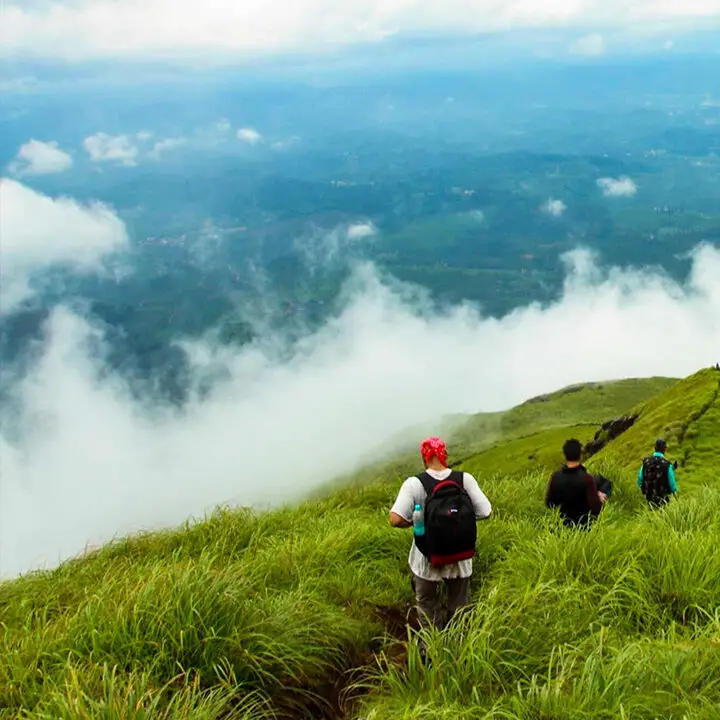
Perched amidst the pristine landscapes of Wayanad, Neelimala Viewpoint stands as a captivating vantage point that unveils the picturesque charm of Kerala’s Western Ghats. This elevated haven invites explorers to witness a breathtaking panorama, offering a visual feast of rolling hills, lush valleys, and the serene expanse of nature.
Traversing the Neelimala Trail:
The journey to Neelimala Viewpoint begins with a trek along a trail that winds through dense forests and undulating terrains. As trekkers ascend, the symphony of rustling leaves and bird calls provides a harmonious backdrop, creating a sense of anticipation for the panoramic spectacle awaiting at the summit. The trail, though moderately challenging, is rewarded with moments of tranquility and natural beauty.
Breathtaking Panorama:
Upon reaching Neelimala Viewpoint, visitors are greeted with a breathtaking panorama that stretches as far as the eye can see. The lush greenery of Wayanad’s hills unfolds in layers, creating a mesmerizing tapestry of varying shades. The panoramic views encompass the Meenmutty Waterfalls, Chembra Peak, and the verdant valleys below, offering an unrivaled visual treat.
Meenmutty Waterfalls: Nature’s Cascading Masterpiece:
Neelimala Viewpoint provides an exquisite view of the Meenmutty Waterfalls, one of Wayanad’s iconic natural wonders. The cascading water descends gracefully, creating a visual symphony against the backdrop of the dense forests. The sight of Meenmutty Waterfalls from Neelimala is a poetic moment that encapsulates the untamed beauty of Kerala’s Western Ghats.
Sunset Spectacle:
Neelimala Viewpoint is not only renowned for its daytime vistas but also for the captivating sunset scenes it offers. As the sun dips below the horizon, the hills and valleys are bathed in hues of orange and pink, casting a warm glow over the landscape. Sunset at Neelimala becomes a serene and soul-stirring experience, creating memories that linger in the heart.
Photographer’s Paradise:
For photography enthusiasts, Neelimala Viewpoint is a paradise of visual delights. The changing hues of the landscape, the play of light and shadow on the hills, and the expansive views provide endless opportunities for capturing the essence of Wayanad’s natural beauty. Every frame tells a story of the unspoiled allure of the Western Ghats.
Flora and Fauna Encounters:
The trek to Neelimala Viewpoint allows explorers to connect with Wayanad’s rich biodiversity. The forests surrounding the trail are home to diverse flora and fauna, offering glimpses of native plant species and the possibility of spotting colorful butterflies and endemic birds. The trek becomes not just a visual journey but an immersive experience with nature.
Responsible Exploration:
To ensure the preservation of Neelimala’s natural beauty, responsible exploration practices are encouraged. Visitors are urged to follow designated trails, avoid littering, and respect the sanctuary’s delicate ecosystem. By adhering to responsible tourism guidelines, travelers contribute to the sustainable conservation of Wayanad’s pristine landscapes.
Karalad Lake: A Tranquil Oasis in Wayanad’s Verdant Embrace
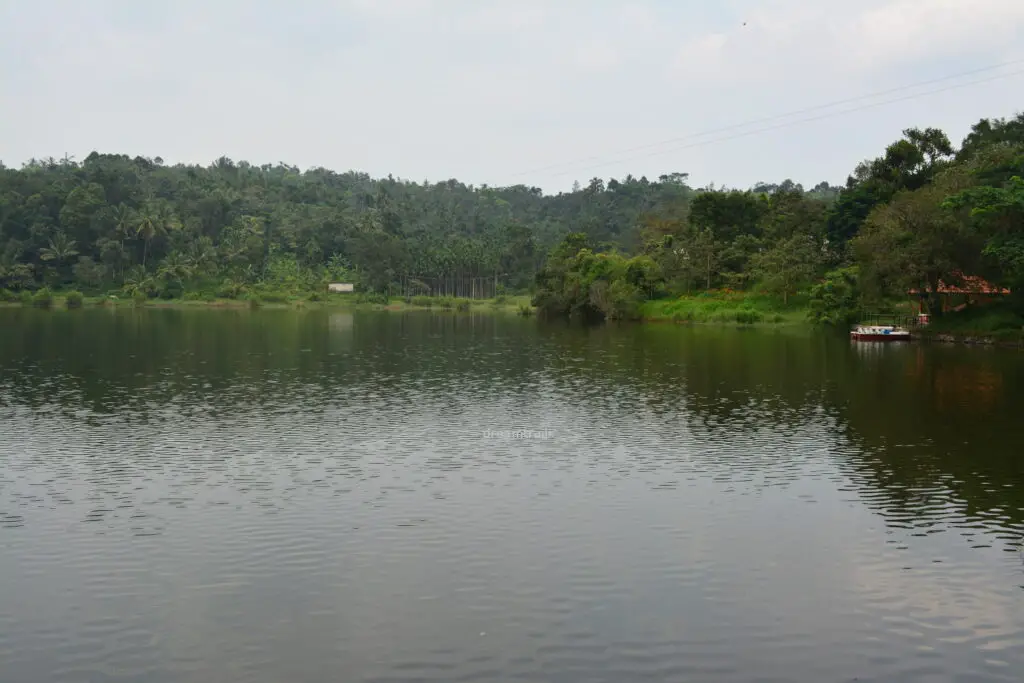
Nestled amid the lush landscapes of Wayanad, Karalad Lake emerges as a serene oasis, inviting travelers to escape the hustle and bustle and immerse themselves in the tranquility of nature. This pristine lake, cradled by the Western Ghats, offers a picturesque setting where visitors can unwind, rejuvenate, and connect with the untouched beauty of Kerala’s highlands.
Natural Splendor:
Karalad Lake captivates with its natural splendor, surrounded by rolling hills, dense forests, and the gentle rustle of leaves. The lake’s crystal-clear waters reflect the greenery that envelops it, creating a tranquil tableau that seamlessly integrates with the verdant landscapes of Wayanad. The untouched beauty of Karalad Lake serves as a reminder of Kerala’s commitment to preserving its pristine environments.
Boating on Karalad Waters:
A highlight of a visit to Karalad Lake is the opportunity to embark on a serene boating experience. Visitors can navigate the tranquil waters, allowing the gentle ripples to create a soothing soundtrack. The boat ride offers a unique perspective of the lake’s surroundings, revealing hidden corners and providing a sense of calmness as the boat glides across the water’s surface.
Birdwatcher’s Paradise:
Karalad Lake is a haven for birdwatchers, attracting a myriad of avian species that thrive in the surrounding habitats. The tranquil ambiance and rich biodiversity create an ideal environment for spotting native and migratory birds. Visitors can delight in the melodies of songbirds, the graceful flight of waterfowl, and the vibrant plumage of the avian residents that call Karalad home.
Picnic Amidst Nature’s Canvas:
The shores of Karalad Lake beckon visitors to partake in the simple pleasures of a lakeside picnic. Surrounded by the serenity of nature, travelers can spread a blanket, savor local delicacies, and bask in the beauty of their surroundings. The peaceful atmosphere makes Karalad Lake an ideal spot for a leisurely day outdoors, connecting with loved ones amidst Wayanad’s idyllic landscapes.
Photography Delights:
For photography enthusiasts, Karalad Lake presents a myriad of opportunities to capture the essence of Wayanad’s natural beauty. The changing hues of the lake, the reflections of surrounding hills, and the diverse flora and fauna provide a visual feast for those seeking to immortalize the moments spent in this pristine locale.
Nature Walks and Trails:
Exploring the surroundings of Karalad Lake goes beyond the waters. Nature walks and trails lead visitors through the adjacent landscapes, unveiling hidden gems and providing glimpses of the diverse ecosystems that thrive in Wayanad. The gentle rustling of leaves and the scent of the wilderness enhance the immersive experience of being in nature’s embrace.
Conservation and Responsible Tourism:
Karalad Lake is a testament to the importance of conservation efforts in preserving natural treasures. Visitors are encouraged to engage in responsible tourism practices, respecting the lake’s ecosystem and following guidelines to minimize their environmental impact. Sustainable tourism ensures that future generations can continue to enjoy the unspoiled beauty of Karalad.
Tranquil Reverence: Exploring the Jain Temple in Sultan Bathery, Wayanad

Nestled in the heart of Wayanad’s historical tapestry, the Jain Temple in Sultan Bathery stands as a testament to the region’s cultural diversity and the timeless allure of its heritage. A visit to this sacred site offers not only a glimpse into the architectural marvels of Jain craftsmanship but also a serene journey into the rich history that has shaped the cultural fabric of Wayanad.
Historical Roots:
The Jain Temple in Sultan Bathery holds a venerable history that dates back centuries. Believed to have been built in the 13th century, this temple stands as a silent witness to the ebb and flow of time in Wayanad. Its ancient stone structures and intricate carvings narrate stories of the Jain community that once flourished in this region.
Architectural Elegance:
The temple’s architectural splendor is a testament to the skill and artistry of the craftsmen of yesteryears. Intricate carvings adorn the temple’s walls, depicting scenes from Jain mythology and showcasing the precision of ancient stone sculptors. The structural elegance and the meticulous detailing stand as a living legacy of the architectural finesse that graced Wayanad centuries ago.
Spiritual Atmosphere:
Stepping into the Jain Temple in Sultan Bathery offers visitors a unique spiritual experience. The hushed ambiance, the scent of incense, and the echoes of ancient prayers create an atmosphere of tranquility. Devotees and visitors alike find solace in the serenity that envelopes the temple, providing a space for contemplation and reverence.
Intricate Jain Iconography:
The temple’s sanctum is adorned with intricate depictions of Jain iconography. Elaborate carvings of Tirthankaras, Jain saints, and celestial beings grace the walls, each telling a story from the Jain scriptures. The symbolism embedded in the carvings adds a layer of depth to the spiritual experience, inviting contemplation on the principles of non-violence, truth, and compassion.
Preservation Efforts:
The Jain Temple in Sultan Bathery stands as a heritage gem, and efforts have been made to preserve its historical significance. Restoration work has been undertaken to maintain the structural integrity of the temple, ensuring that future generations can continue to witness and appreciate the architectural and cultural marvel it represents.
Harmony of Religions:
The Jain Temple’s presence in Sultan Bathery highlights the harmonious coexistence of diverse religious communities in Wayanad. In a region that has been a melting pot of cultures and traditions, this temple symbolizes the acceptance and mutual respect that has defined Wayanad’s social fabric over the centuries.
Visiting Guidelines:
To fully appreciate the spiritual and historical significance of the Jain Temple, visitors are encouraged to adhere to the guidelines set by the temple authorities. Respecting the sanctity of the space, avoiding disruptive behavior, and dressing modestly contribute to maintaining the sacred atmosphere for all visitors.
Ambukuthi Mala: A Mystical Odyssey Through Wayanad’s Ancient Rocks

Nestled in the emerald embrace of Wayanad’s lush landscapes, Ambukuthi Mala stands as a geological marvel and a testament to the region’s rich history. This ancient rock formation, etched with enigmatic carvings and surrounded by verdant hills, offers intrepid explorers a journey through time and a glimpse into the cultural tapestry of Kerala’s highlands.
Geological Enigma:
Ambukuthi Mala, also known as Ambukuthi Hills, is a rocky terrain that captivates with its unique geological features. The undulating expanse of rocks, formed millions of years ago, tells the geological tale of Wayanad’s ancient past. The weathered boulders and craggy outcrops create an otherworldly landscape that beckons adventurers to unravel its mysteries.
Edakkal Caves: Rock Art Chronicles:
At the heart of Ambukuthi Mala lie the renowned Edakkal Caves, a series of ancient rock shelters that have borne witness to human presence for thousands of years. The caves are adorned with prehistoric petroglyphs and pictorial carvings that depict scenes of hunting, dancing, and daily life from a bygone era. These rock engravings serve as a fascinating archaeological treasure trove, providing a window into the lives of ancient civilizations.
Historical Significance:
The historical significance of Ambukuthi Mala is deeply intertwined with the Edakkal Caves, which have been recognized as one of the earliest centers of human habitation in the Western Ghats. Archaeological excavations have unearthed artifacts dating back to the Neolithic and Megalithic ages, establishing the site as a crucial link to understanding the cultural evolution of Wayanad.
Edakkal Caves Trek:
The journey to Ambukuthi Mala unfolds through a trek to the Edakkal Caves, offering a blend of adventure and historical exploration. The trail winds through the dense forests and rocky terrains, providing glimpses of Wayanad’s diverse flora and fauna. As trekkers ascend, the anticipation builds, leading to the awe-inspiring moment when the ancient caves come into view.
Panoramic Views:
The ascent to Ambukuthi Mala rewards trekkers with panoramic vistas of Wayanad’s rolling hills and distant valleys. The elevated vantage point offers a breathtaking perspective of the surrounding landscapes, creating a sense of oneness with the natural beauty that defines the Western Ghats.
Cultural Odyssey:
Ambukuthi Mala’s cultural significance extends beyond its geological and archaeological marvels. The site is deeply rooted in local folklore and legends, adding a layer of mystique to the exploration. The cultural odyssey through Ambukuthi Mala becomes an immersive experience, connecting visitors to the ancient narratives that have shaped the identity of Wayanad.
Preservation Efforts:
Recognizing the cultural and ecological importance of Ambukuthi Mala, conservation initiatives have been undertaken to preserve the site. Sustainable tourism practices and efforts to protect the natural surroundings ensure that future generations can continue to marvel at the enigmatic rocks and historic caves.
Phantom Rock: Nature’s Spectacular Sculpture in Wayanad
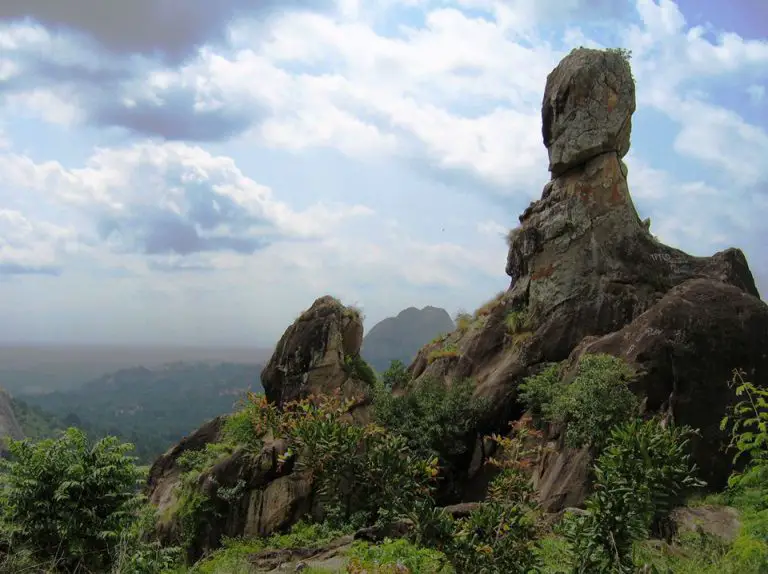
In the heart of Wayanad’s enchanting landscapes, Phantom Rock stands as a geological marvel, captivating visitors with its eerie yet mesmerizing formation. This natural sculpture, sculpted by the hands of time, rises mysteriously from the earth, inviting explorers to witness the unique beauty that graces the Western Ghats.
Mysterious Silhouette:
Phantom Rock derives its name from its uncanny resemblance to a colossal skull or the head of a phantom. The rock formation, characterized by a massive metamorphic rock balanced precariously on a smaller stone base, creates an illusion that stirs the imagination. The silhouette against the sky invokes a sense of wonder and an air of mystique, making Phantom Rock a must-visit destination for those seeking nature’s artistic wonders.
Geological Formation:
The geological origins of Phantom Rock add to its allure. Composed of metamorphic rocks shaped by weathering and erosion over millions of years, this natural sculpture is a testament to the intricate dance between nature and time. The precision with which the rocks balance defies conventional explanations, leaving observers in awe of the forces that shaped this unique formation.
Accessing Phantom Rock:
The journey to Phantom Rock is an adventure in itself. Accessible by a trek through the picturesque landscapes of Wayanad, the trail to Phantom Rock offers panoramic views of the surrounding hills and valleys. The trek takes explorers through dense forests and open meadows, providing an immersive experience in the natural beauty that envelopes this geological wonder.
Panoramic Vistas:
Upon reaching Phantom Rock, visitors are rewarded with panoramic vistas that extend to the horizon. The elevated location provides breathtaking views of Wayanad’s undulating hills, creating a serene and tranquil ambiance. The surrounding greenery, coupled with the enigmatic rock formation, makes Phantom Rock an ideal spot for nature enthusiasts and photographers alike.
Cultural Legends:
Phantom Rock is steeped in local folklore and legends that add a cultural layer to its mystique. According to tales passed down through generations, the rock formation is believed to have been the result of a mythical creature’s presence. The cultural narratives further enhance the sense of wonder associated with Phantom Rock, inviting visitors to ponder the stories embedded in the region’s rich heritage.
Photographer’s Paradise:
For photography enthusiasts, Phantom Rock is a paradise of visual opportunities. The interplay of light and shadow on the rocks, the changing hues of the sky during sunrise and sunset, and the unique contours of the formation provide a captivating canvas for capturing nature’s artistry. The ethereal atmosphere at different times of the day adds a magical touch to every frame.
Conservation and Responsible Tourism:
To ensure the preservation of Phantom Rock’s natural beauty, responsible tourism practices are essential. Visitors are encouraged to follow designated trails, avoid littering, and respect the ecological balance of the region. By adhering to conservation guidelines, explorers contribute to the longevity of Phantom Rock and the protection of Wayanad’s delicate ecosystems.
Banasura Ayurvedic Centre: Nurturing Wellness Amidst Nature’s Bounty

Nestled in the pristine landscapes of Wayanad, the Banasura Ayurvedic Centre beckons seekers of holistic well-being with the promise of rejuvenation and healing. Surrounded by the lush greenery of the Western Ghats, this wellness haven is dedicated to the ancient science of Ayurveda, offering a sanctuary where traditional healing practices harmonize with nature’s bounty.
Ayurveda’s Timeless Wisdom:
Banasura Ayurvedic Centre is a testament to the timeless wisdom of Ayurveda, the ancient holistic healing system that originated in India thousands of years ago. Rooted in the principles of balance and harmony, Ayurveda seeks to align the body, mind, and spirit to promote overall well-being. The center embodies these principles, creating a space where guests can embark on a transformative journey to health and vitality.
Serenity Amidst Nature:
Situated in the lap of Wayanad’s serene landscapes, Banasura Ayurvedic Centre is enveloped by the natural beauty of the region. The tranquil ambiance, with the sounds of birdsong and rustling leaves, provides an ideal backdrop for the rejuvenation process. The center’s location allows guests to connect with nature’s soothing embrace, enhancing the healing experience.
Holistic Healing Therapies:
At the heart of Banasura Ayurvedic Centre are the holistic healing therapies deeply rooted in Ayurvedic principles. Trained Ayurvedic practitioners offer personalized consultations to understand individual health needs. Tailored treatment plans may include traditional therapies such as Abhyanga (oil massage), Shirodhara (oil pouring on the forehead), and Panchakarma, a detoxification and purification process.
Organic Farm-to-Table Cuisine:
Nourishment plays a vital role in the Ayurvedic healing journey. Banasura Ayurvedic Centre takes pride in offering organic, farm-to-table cuisine that aligns with Ayurvedic dietary principles. Locally sourced, seasonal ingredients are thoughtfully combined to create wholesome and nutritious meals that support the body’s natural balance and digestion.
Yoga and Meditation:
Complementing the Ayurvedic therapies, Banasura Ayurvedic Centre integrates yoga and meditation into its wellness programs. Expert instructors guide guests through asanas (postures) and mindfulness practices, fostering a holistic approach to mental and physical well-being. The serene surroundings provide an idyllic setting for introspection and self-discovery.
Customized Wellness Retreats:
Banasura Ayurvedic Centre offers customized wellness retreats, allowing guests to tailor their experience based on individual health goals. Whether seeking stress relief, detoxification, or overall rejuvenation, the center’s programs are designed to provide a holistic and immersive wellness experience.
Ayurvedic Lifestyle Guidance:
Beyond treatments and therapies, the center provides Ayurvedic lifestyle guidance to empower guests with the knowledge to maintain balance in their daily lives. This may include dietary recommendations, daily routines (Dinacharya), and practices to align with natural rhythms, fostering long-term well-being.
Cultural Immersion:
Banasura Ayurvedic Centre offers guests the opportunity to immerse themselves in the cultural richness of Wayanad. Cultural activities, traditional performances, and guided nature walks contribute to a holistic experience that embraces the local heritage and connects guests with the spirit of the region.
Environmental Sustainability:
The center is committed to environmental sustainability, incorporating eco-friendly practices into its operations. From waste management to energy conservation, Banasura Ayurvedic Centre strives to minimize its ecological footprint, aligning with the principles of Ayurveda’s connection to nature.
Sunrise Valley Wayanad: A Picturesque Dawn Amidst Nature’s Splendor

Perched in the heart of Wayanad’s enchanting landscapes, Sunrise Valley unfolds as a haven for those seeking the serenity of dawn amidst the pristine beauty of Kerala’s Western Ghats. This idyllic location, aptly named for its breathtaking sunrise vistas, invites nature enthusiasts and adventurers to witness the first light of day in a setting that epitomizes Wayanad’s natural splendor.
Enchanting Location:
Sunrise Valley is situated in a secluded corner of Wayanad, away from the hustle and bustle of urban life. Surrounded by undulating hills, lush greenery, and the gentle murmur of flowing streams, this picturesque valley offers an escape into nature’s embrace. The tranquility of the location sets the stage for a serene and awe-inspiring sunrise experience.
Dawn’s Embrace:
The highlight of Sunrise Valley is, undoubtedly, the enchanting sunrise that graces the horizon. As the first rays of sunlight pierce through the mist-kissed hills, the valley undergoes a magical transformation. The play of light and shadow creates a mesmerizing palette of colors, painting the sky in hues of orange, pink, and gold. The dawn at Sunrise Valley is a sensory symphony, accompanied by the chorus of awakening birds and the rustling of leaves.
Scenic Trek to the Valley:
The journey to Sunrise Valley often involves a scenic trek through Wayanad’s verdant landscapes. The trekking trail meanders through forests, grassy meadows, and hilly terrains, offering glimpses of the region’s diverse flora and fauna. The anticipation builds with every step, culminating in the breathtaking revelation of the valley as the trek reaches its pinnacle.
Photographer’s Paradise:
For photography enthusiasts, Sunrise Valley is a true paradise. The ever-changing hues of the sky, the silhouettes of hills against the dawn, and the reflection of the sun’s first rays on the valley floor provide an exquisite canvas for capturing nature’s artistry. Each moment becomes a frame-worthy snapshot, preserving the essence of the valley’s ethereal beauty.
Nature’s Wake-Up Call:
Apart from the visual spectacle, Sunrise Valley offers a unique auditory experience. The sounds of nature coming to life—the chirping of birds, the rustling of leaves, and the distant flow of streams—create a harmonious symphony that accompanies the sunrise. It is a sensory awakening, inviting visitors to connect with the rhythms of the natural world.
Yoga and Meditation Retreats:
Sunrise Valley also serves as a tranquil setting for yoga and meditation retreats. The serene surroundings provide an ideal atmosphere for mindfulness practices, allowing participants to harmonize their energies with the rising sun. The valley becomes a sanctuary for those seeking a holistic and rejuvenating experience.
Conservation and Responsible Tourism:
Preserving the pristine beauty of Sunrise Valley is paramount. Responsible tourism practices are encouraged, emphasizing the importance of minimizing environmental impact. Visitors are urged to follow designated trails, avoid littering, and respect the delicate ecosystems that define Wayanad’s highlands.
Pakshipathalam Bird Sanctuary: A Avian Haven in Wayanad’s Wilderness
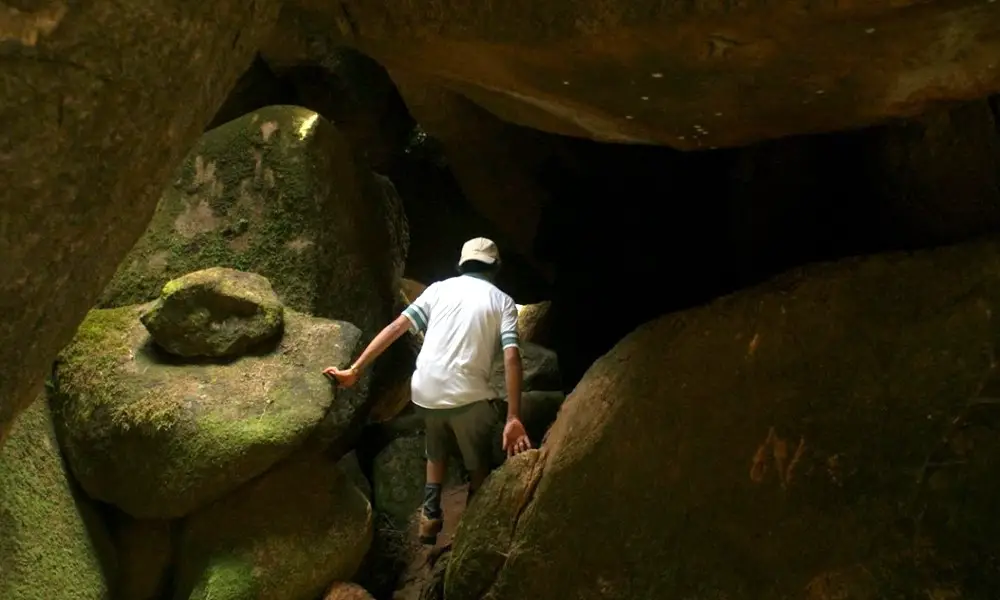
Nestled amidst the dense forests of Wayanad, Pakshipathalam Bird Sanctuary emerges as a sanctuary for avian enthusiasts and nature lovers. This hidden gem, veiled in the verdant landscapes of Kerala’s Western Ghats, provides a unique opportunity to witness the vibrant avifauna that calls the region home.
Mystical Setting:
Pakshipathalam, translating to “bird sanctuary” in Malayalam, is aptly named for its mystical setting. Tucked away in the Brahmagiri Hills, this sanctuary is known for its undulating terrains, lush greenery, and a network of caves that add an air of mystique to the birdwatching experience. The sanctuary’s remote location contributes to its pristine and unspoiled ambiance.
Avian Diversity:
Pakshipathalam is a haven for birdwatchers, boasting a rich diversity of avian species. The sanctuary’s dense forests and diverse ecosystems create an ideal habitat for a myriad of bird species, both resident and migratory. The symphony of birdcalls, from melodious songs to distinctive calls, fills the air as visitors traverse the sanctuary’s trails.
Endangered Species:
The bird sanctuary is home to several endangered and endemic species, making it a crucial area for bird conservation efforts. Endangered species like the Wayanad Laughingthrush and the Nilgiri Wood Pigeon find refuge in the sanctuary’s protected environs. Conservation initiatives contribute to the preservation of these avian treasures.
Trekking Adventure:
Exploring Pakshipathalam is an adventure in itself, often involving a trek through the dense forests. The trek takes visitors through winding trails, offering glimpses of the sanctuary’s diverse flora and fauna. The rugged terrain and the anticipation of bird sightings create an immersive experience for those seeking an adventure in Wayanad’s wilderness.
Cave Exploration:
Pakshipathalam is renowned for its intricate network of caves, adding an extra layer of fascination to the birdwatching experience. The caves are believed to have historical and mythological significance, contributing to the sanctuary’s allure. Exploring these natural caverns provides an opportunity to witness unique geological formations and, occasionally, discover new bird habitats.
Butterfly Encounters:
Beyond its avian inhabitants, Pakshipathalam is also known for its vibrant butterfly population. The fluttering wings of these delicate insects add a kaleidoscopic touch to the sanctuary’s landscapes. Butterfly enthusiasts will find joy in observing the various species that grace the meadows and trails.
Conservation and Responsible Tourism:
Preserving the ecological balance of Pakshipathalam is essential for the continued well-being of its avian residents. Responsible tourism practices, including staying on designated trails, minimizing noise pollution, and respecting the sanctuary’s flora and fauna, are crucial to sustaining the sanctuary’s pristine environment.
Guided Tours and Naturalists:
To enhance the birdwatching experience, guided tours led by experienced naturalists are available. These experts offer insights into the behavior, habitats, and unique characteristics of the avian species that inhabit Pakshipathalam. Their knowledge enriches the visit, making it both educational and immersive.
Chain Tree of Karinthandan: Unraveling the Legend in Wayanad

Nestled amid the enchanting landscapes of Wayanad, the Chain Tree of Karinthandan stands as a silent witness to a legendary tale that weaves together history, folklore, and the cultural tapestry of Kerala. This ancient ficus tree, adorned with chains, is more than a botanical wonder—it is a symbol of a poignant narrative that has resonated through generations.
The Legend of Karinthandan:
The story dates back to the construction of the Ghat road that winds its way through the mist-laden hills of Wayanad. Legend has it that Karinthandan, a local tribal guide, played a pivotal role in guiding a British engineer and his team through the treacherous terrains. Recognizing the strategic importance of the road, Karinthandan led the way, marking trails through the dense forests.
Tragic Betrayal:
However, the tale takes a tragic turn. Fearing that Karinthandan would reveal the secret routes and make the road accessible to others, the British engineer betrayed him. In a heart-wrenching act of betrayal, Karinthandan was allegedly killed, and his body was hung from a ficus tree—the now-famous Chain Tree.
Ficus Tree’s Unusual Growth:
What makes the Chain Tree truly extraordinary is its unusual growth pattern. The ficus tree, believed to be the very one where Karinthandan met his tragic end, has grown with chains embedded in its trunk. Local lore suggests that the chains have mysteriously appeared over the years, symbolizing the spirit of Karinthandan and his sacrifice.
Symbol of Remembrance:
The Chain Tree serves as a poignant symbol of remembrance and reflection on the region’s historical and cultural complexities. Visitors to Wayanad often stop by this living relic to pay homage to the memory of Karinthandan and to contemplate the impact of colonial history on the indigenous communities of the Western Ghats.
Cultural Heritage:
The Chain Tree transcends its botanical existence and becomes an integral part of Wayanad’s cultural heritage. It stands as a tangible link to a bygone era, prompting reflection on the shared history of the local communities and the challenges they faced during the colonial period.
Tourist Attraction:
Today, the Chain Tree has become a unique tourist attraction in Wayanad. Travelers and history enthusiasts alike visit the site not only to witness the remarkable growth of the ficus tree but also to delve into the story it encapsulates. The Chain Tree stands as a testament to the resilience of the local communities and their ability to preserve their cultural narratives.
Conservation and Respect:
Preserving the Chain Tree and the legend it represents is crucial for Wayanad’s cultural and historical identity. Visitors are encouraged to approach the site with respect, following designated paths and refraining from any activities that could harm the tree. Conservation efforts ensure that future generations can continue to unravel the compelling story of Karinthandan and the Chain Tree.
Jog Falls of Wayanad: Nature’s Cascading Symphony
Nestled in the heart of the Western Ghats, the Jog Falls of Wayanad cascade down the verdant hills, creating a breathtaking spectacle that resonates with the rhythmic harmony of nature. This captivating waterfall, surrounded by lush landscapes, stands as a testament to Wayanad’s enchanting beauty and the power of water to shape the land.
Majestic Descent:
The Jog Falls of Wayanad, not to be confused with the more famous Jog Falls in Karnataka, is a series of tiered cascades that gracefully descend the undulating hills. The water flows in stages, creating a mesmerizing display as it interacts with the rocky terrain, forming pools and rapids along its course. The sight of water plunging down the hills is a majestic dance of liquid grace.
Seasonal Splendor:
The appearance of the Jog Falls varies with the seasons, adding to its allure. During the monsoon, the waterfall transforms into a mighty torrent, its waters gushing with unmatched force. In the drier months, the flow may recede, revealing the intricate rock formations that lie beneath. Regardless of the season, the Jog Falls captivate visitors with their ever-changing beauty.
Accessing the Falls:
Reaching the Jog Falls often involves a trek through Wayanad’s picturesque landscapes. The journey to the falls takes visitors through dense forests, across streams, and along winding trails, providing an immersive experience in the region’s natural beauty. The anticipation builds with each step, leading to the grand reveal of the cascading spectacle.
Photographer’s Paradise:
For photographers and nature enthusiasts, the Jog Falls present an irresistible subject. The interplay of light and water, the lush greenery that surrounds the falls, and the dynamic flow of the cascades create a captivating scene. The falls’ tiered structure offers unique angles for capturing the essence of Wayanad’s untamed landscapes.
Biodiversity and Ecological Richness:
The area surrounding the Jog Falls is characterized by its rich biodiversity. The moist deciduous forests and the riparian ecosystems that flourish along the watercourse contribute to the region’s ecological wealth. Birdwatchers may spot various avian species, while the diverse flora adds to the overall vibrancy of the surroundings.
Conservation and Responsible Tourism:
Preserving the natural beauty of the Jog Falls is paramount for its long-term sustainability. Responsible tourism practices, such as staying on designated paths, avoiding littering, and respecting the local flora and fauna, play a crucial role in maintaining the ecological balance of the region. Conservation efforts ensure that future generations can continue to marvel at the grandeur of the falls.
Cultural Significance:
In addition to its natural splendor, the Jog Falls may also hold cultural significance in local folklore. The falls might be woven into the narratives of indigenous communities, contributing to Wayanad’s rich tapestry of stories and traditions. Visitors are often encouraged to learn about and respect the cultural heritage associated with the falls.
Kanthanpara Waterfalls: A Tranquil Cascade in Wayanad’s Wilderness
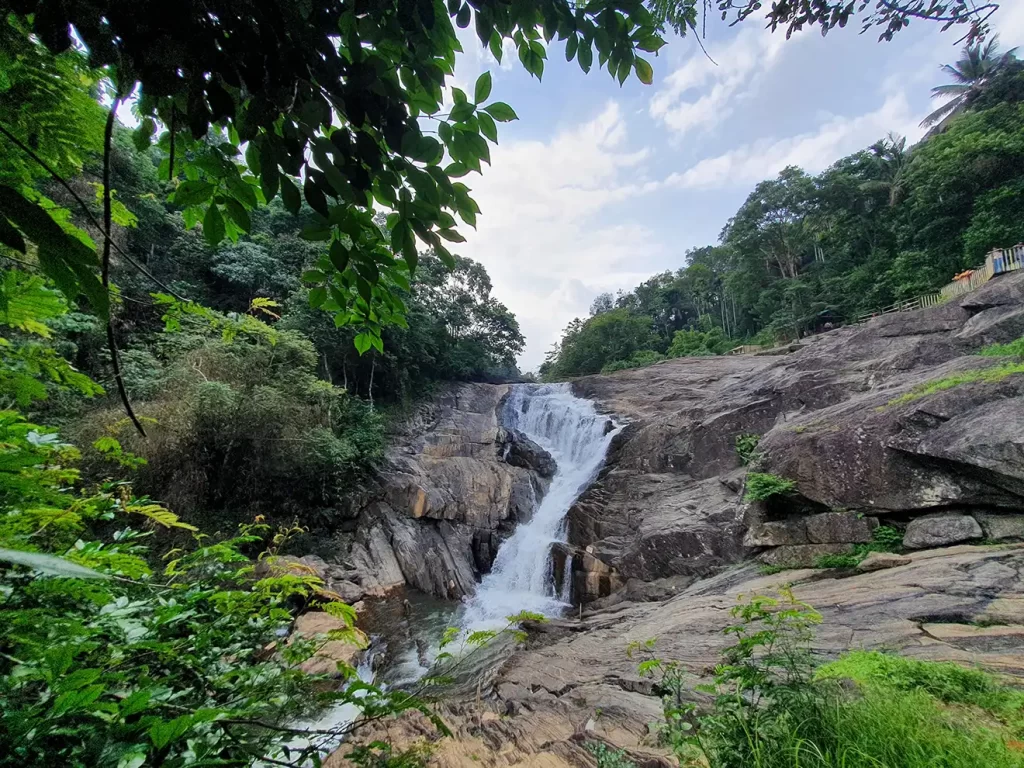
Nestled in the pristine landscapes of Wayanad, Kanthanpara Waterfalls unfolds as a serene and lesser-known gem, offering visitors a tranquil retreat amidst nature’s bounty. This picturesque waterfall, tucked away in the heart of the Western Ghats, captivates with its gentle cascade and the peaceful ambiance that defines Wayanad’s unspoiled wilderness.
Scenic Setting:
Kanthanpara Waterfalls is situated in the midst of lush greenery, surrounded by dense forests and undulating hills. The tranquil setting provides a welcome escape from the hustle and bustle of urban life, inviting visitors to immerse themselves in the soothing sounds of cascading water and the symphony of nature that envelops the falls.
Accessing the Falls:
Reaching Kanthanpara Waterfalls often involves a scenic trek through Wayanad’s verdant landscapes. The trekking trail takes visitors along winding paths, providing glimpses of the region’s diverse flora and fauna. As the journey progresses, the distant sounds of falling water serve as a melodic guide, leading to the hidden beauty of Kanthanpara.
Cascading Symphony:
The highlight of Kanthanpara Waterfalls is its gentle cascade, which descends gracefully down the rocky terrain. Unlike more forceful waterfalls, Kanthanpara creates a cascading symphony that blends seamlessly with the natural surroundings. The crystal-clear water forms small pools along its descent, creating a tranquil space for reflection and relaxation.
Photographer’s Delight:
For photography enthusiasts, Kanthanpara Waterfalls offers a canvas of natural beauty. The play of light on the water, the lush greenery that frames the falls, and the serene ambiance make it an ideal setting for capturing the essence of Wayanad’s pristine landscapes. The falls’ intimate scale allows for close-up shots, emphasizing the details of the cascading water.
Seasonal Variations:
The appearance of Kanthanpara Waterfalls can vary with the seasons. During the monsoon, the falls come to life with increased water flow, creating a lush and vibrant scene. In the drier months, the water may recede, revealing the underlying rock formations. Each season brings its own charm, ensuring that visitors experience a dynamic and ever-changing landscape.
Conservation and Responsible Tourism:
Preserving the natural beauty of Kanthanpara Waterfalls is essential for its long-term sustainability. Responsible tourism practices, such as staying on designated paths, avoiding littering, and respecting the local flora and fauna, contribute to the conservation of this pristine environment. Conservation efforts ensure that the falls remain a sanctuary for nature lovers for generations to come.
Nearby Attractions:
Kanthanpara Waterfalls is often part of a larger exploration of Wayanad’s attractions. Visitors may choose to combine their visit with nearby points of interest, such as tea estates, wildlife sanctuaries, or other waterfalls in the region. The falls become a tranquil stop along the journey through Wayanad’s diverse landscapes.
Wayanad Spice Plantations: A Fragrant Journey into Kerala’s Culinary Heritage

Nestled in the lush hills of Kerala’s Western Ghats, Wayanad Spice Plantations invite visitors on a fragrant journey into the heart of India’s spice country. This verdant region is not only renowned for its breathtaking landscapes but also for the vibrant tapestry of spices that have shaped its culinary heritage. Embarking on a tour of Wayanad’s spice plantations offers a sensory exploration that engages sight, smell, and taste.
Diverse Spice Varieties:
Wayanad’s spice plantations boast a rich diversity of aromatic treasures. Cardamom, pepper, cinnamon, cloves, nutmeg, and ginger are just a few of the spices that thrive in the region’s favorable climate and fertile soil. Each plantation becomes a living canvas, painted with vibrant hues and filled with the intoxicating aromas of these culinary gems.
Guided Spice Tours:
To fully appreciate the richness of Wayanad’s spice culture, guided tours through the plantations are available. Knowledgeable guides lead visitors through the lush groves, explaining the cultivation methods, harvesting techniques, and the unique characteristics of each spice. The tours provide an immersive experience, allowing guests to witness the journey from plant to spice.
Hands-On Experience:
Many spice plantations in Wayanad offer hands-on experiences, allowing visitors to actively engage in the spice cultivation process. This may include plucking fresh spices, participating in the drying and processing stages, and gaining insights into the traditional and sustainable farming practices employed in the region.
Sensory Delight:
As visitors walk through the plantations, the air becomes infused with the heady scents of spices wafting through the breeze. The sensory delight is not limited to the olfactory experience; it extends to the visual feast of vibrant greenery, interspersed with bursts of color from blooming flowers. The combination of sights and scents creates a truly immersive encounter with Wayanad’s spice heritage.
Culinary Workshops:
For those eager to extend their spice journey to the palate, some plantations offer culinary workshops. Skilled chefs guide participants through the art of using spices in traditional Kerala cuisine. From learning to prepare masala chai to understanding the intricacies of spice blends, these workshops provide a hands-on exploration of Wayanad’s culinary traditions.
Eco-Friendly Practices:
Many spice plantations in Wayanad are committed to eco-friendly and sustainable farming practices. From organic cultivation methods to responsible water management, these plantations prioritize environmental conservation. Visitors gain insight into the delicate balance between agriculture and nature, fostering an appreciation for sustainable spice cultivation.
Local Spice Products:
Visitors often have the opportunity to purchase locally sourced and freshly processed spice products. These may include aromatic spice blends, essential oils, and handmade soaps. Taking home these authentic products becomes a tangible connection to the flavors and scents of Wayanad’s spice plantations.
Conservation and Preservation:
Preserving the biodiversity of Wayanad’s spice plantations is integral to the region’s cultural and ecological sustainability. Responsible tourism practices, such as supporting organic farming initiatives and respecting the natural habitats of the plantations, contribute to the long-term preservation of this unique spice heritage.
Vyithiri Village Resort: Where Nature and Luxury Coalesce

Nestled in the sylvan landscapes of Wayanad, Vyithiri Village Resort beckons travelers with the promise of a serene retreat amidst nature’s embrace. This luxurious haven seamlessly integrates the charm of Wayanad’s verdant surroundings with opulent accommodation, offering a tranquil escape for those seeking respite from the hustle and bustle of everyday life.
Nature-Inspired Architecture:
Vyithiri Village Resort is not merely a place of accommodation; it is a harmonious extension of its natural surroundings. The architecture of the resort is inspired by the traditional Malabar style, seamlessly blending with the lush greenery that envelops it. The use of natural materials and the open design ethos create an ambiance that fosters a deep connection with the serene landscape.
Luxurious Accommodations:
The resort boasts a range of luxurious accommodations, from well-appointed rooms to spacious cottages and treehouses. Each unit is designed to provide a perfect blend of modern comforts and rustic charm. Guests have the opportunity to wake up to the melodies of birdsong, surrounded by the panoramic views of Wayanad’s undulating hills.
Sustainable Practices:
Vyithiri Village Resort is committed to sustainable and eco-friendly practices. The resort’s architecture and operations are designed to minimize its environmental impact. From rainwater harvesting to waste management, the resort endeavors to preserve the natural beauty that makes Wayanad a sought-after destination.
Ayurvedic Wellness:
For those seeking rejuvenation, the resort offers Ayurvedic wellness experiences. Trained therapists provide traditional Ayurvedic treatments and massages that promote holistic well-being. The therapeutic properties of Ayurveda, combined with the serene ambiance of Wayanad, create a perfect environment for relaxation and rejuvenation.
Culinary Delights:
The resort’s culinary offerings are a gastronomic journey through the flavors of Kerala. Locally sourced ingredients, including spices from the region, find their way into the dishes served at the resort’s restaurants. Guests can savor authentic Malabar cuisine while surrounded by the natural beauty that defines Wayanad.
Adventure and Exploration:
Vyithiri Village Resort serves as an ideal base for exploring Wayanad’s myriad attractions. The resort organizes guided treks, nature walks, and plantation tours, allowing guests to immerse themselves in the region’s biodiversity. The adventurous can opt for activities like zip-lining and river crossing, adding an extra layer of excitement to their stay.
Picturesque Plantations:
Surrounded by expansive plantations, the resort offers guests the chance to witness the cultivation of spices, coffee, and tea. Guided tours through these plantations provide insights into the agricultural practices that have been a part of Wayanad’s heritage for generations. Guests can engage in hands-on experiences, plucking fresh produce and learning about the cultivation process.
Cultural Experiences:
Vyithiri Village Resort goes beyond being a luxurious abode; it serves as a gateway to Wayanad’s cultural richness. The resort organizes cultural performances, showcasing traditional music and dance forms. Guests can also participate in workshops to learn about local arts and crafts, creating a deeper connection with the heritage of the region.
Lakkidi Viewpoint: A Gateway to Wayanad’s Enchanting Vistas

Perched atop the undulating hills of Wayanad, Lakkidi Viewpoint stands as a panoramic gateway to the natural splendor of Kerala’s Western Ghats. Renowned as the “Gateway of Wayanad,” this vantage point offers visitors an awe-inspiring vista of mist-laden valleys, lush greenery, and winding mountain roads. A visit to Lakkidi Viewpoint promises a visual symphony that captivates the senses and provides a memorable introduction to Wayanad’s captivating landscapes.
Spectacular Scenery:
Lakkidi Viewpoint, situated at an elevation of 700 meters above sea level, provides an unparalleled view of the picturesque landscapes that define Wayanad. As visitors approach the viewpoint, the winding roads reveal breathtaking scenes of mist-covered mountains, dense forests, and the verdant expanse that stretches as far as the eye can see. The viewpoint encapsulates the essence of Wayanad’s pristine beauty.
Hairpin Bends and Vistas:
The journey to Lakkidi involves navigating through a series of nine hairpin bends, adding an adventurous charm to the experience. These bends not only showcase the engineering marvel of the mountain roads but also unveil progressively stunning vistas with each turn. The ascent culminates at Lakkidi Viewpoint, where travelers are treated to a panoramic spectacle of Wayanad’s enchanting topography.
Misty Mornings and Sunset Serenity:
Lakkidi is often enveloped in mist during the early hours, creating an ethereal atmosphere that adds to the allure of the viewpoint. Mist-covered valleys and hills evoke a sense of tranquility, making sunrise visits a popular choice for those seeking a serene start to the day. Additionally, the viewpoint offers a front-row seat to the magical hues of the sunset, transforming the landscape into a canvas of warm colors.
Photographer’s Paradise:
For photography enthusiasts, Lakkidi Viewpoint is a paradise of visual delights. The changing play of light and shadow, the mist that shrouds the hills, and the vibrant greenery provide endless opportunities for capturing the natural beauty of Wayanad. The viewpoint becomes a canvas for photographers to frame the essence of the Western Ghats.
Nature Trails and Trekking:
Lakkidi Viewpoint is not just a stop for a scenic view; it also serves as a starting point for nature trails and treks. Adventure seekers can explore the surrounding hills and forests, discovering the biodiversity that thrives in this region. The cool climate and the crisp mountain air make Lakkidi an ideal location for outdoor enthusiasts.
Local Markets and Refreshments:
Adjacent to the viewpoint, visitors can explore local markets offering traditional handicrafts, spices, and souvenirs. Refreshment stalls provide an opportunity to savor local snacks and beverages while enjoying the view. The markets offer a glimpse into the vibrant culture of Wayanad, allowing visitors to take home a piece of the region’s heritage.
Conservation and Responsible Tourism:
Preserving the ecological balance of Lakkidi Viewpoint is crucial for sustaining its natural beauty. Responsible tourism practices, such as avoiding littering, respecting the local flora and fauna, and staying on designated paths, contribute to the long-term conservation of this pristine environment.
Conclusion:
Wayanad, with its diverse landscapes, rich cultural heritage, and abundant natural beauty, stands as a multifaceted gem in the crown of Kerala’s Western Ghats. The 30+ places mentioned in this comprehensive guide offer a glimpse into the myriad experiences that await visitors in this enchanting district.
From the misty peaks of Chembra to the historical tales echoing in Edakkal Caves, and from the lush tea plantations to the serene waters of Pookode Lake, Wayanad unfolds a tapestry of wonders. The adventure seekers, nature enthusiasts, history buffs, and those seeking tranquility all find their haven in the varied attractions scattered across this district.
Banasura Sagar Dam, Thirunelli Temple, and Meenmutty Falls beckon with their own unique charm, while the spice plantations and Ayurvedic retreats offer a sensory journey into the heart of Kerala’s natural bounty. The cultural richness, coupled with responsible tourism practices, ensures that Wayanad remains a sustainable destination for generations to come.
As visitors traverse through the district, they not only witness the beauty of landscapes but also immerse themselves in the stories that have shaped Wayanad’s identity. Whether exploring historical sites, trekking through lush forests, or simply relishing the tranquility of its viewpoints, Wayanad invites all to become part of its narrative.
In the heart of Wayanad, the 30+ places mentioned are not just destinations on a map; they are gateways to experiences that linger in the memory. Each site carries a piece of the district’s soul, contributing to the collective tale of Kerala’s highlands. For those seeking a destination where nature and culture harmonize, Wayanad is an invitation to embark on a journey of discovery, reflection, and enchantment—a journey that transcends the ordinary and unveils the extraordinary.
FAQs
Q: What makes Wayanad a popular tourist destination?
Wayanad is renowned for its diverse landscapes, including misty mountains, lush forests, pristine lakes, and historical sites. The district offers a perfect blend of natural beauty, cultural richness, and adventure.
2. Q: How many days should I plan for a visit to Wayanad to explore these 30+ places?
The duration of your visit depends on your interests and the depth of exploration you desire. A well-planned trip for a comprehensive experience may span 4 to 6 days.
3. Q: Are there opportunities for adventure activities in Wayanad?
Yes, Wayanad offers various adventure activities such as trekking, wildlife safaris, zip-lining, and boating. Chembra Peak trek, Banasura Hill trek, and wildlife sanctuaries are popular choices.
4. Q: Are there family-friendly attractions in Wayanad?
Absolutely! Wayanad has family-friendly attractions like Pookode Lake, Wayanad Heritage Museum, and Soochipara Waterfalls, providing enjoyable experiences for all age groups.
5. Q: What is the best time to visit Wayanad?
The best time to visit Wayanad is during the post-monsoon (September to March) and pre-monsoon (June to August) seasons when the weather is pleasant, and the landscapes are lush.
6. Q: Can I find accommodation near these attractions?
Yes, Wayanad offers a range of accommodations, including resorts, hotels, and homestays, located in proximity to popular attractions. It’s advisable to book in advance, especially during peak tourist seasons.
7. Q: Are there any cultural experiences in Wayanad?
Yes, Wayanad has cultural experiences like traditional dance performances, visits to tribal villages, and interactions with local artisans. These experiences provide insights into the rich cultural heritage of the region.
8. Q: Are there wildlife sanctuaries in Wayanad?
Yes, Wayanad is home to wildlife sanctuaries such as Muthanga Wildlife Sanctuary and Tholpetty Wildlife Sanctuary, offering opportunities for wildlife safaris and nature walks.
9. Q: Can I explore Wayanad on my own, or should I hire a guide?
While some attractions can be explored independently, hiring a local guide is recommended for a more enriching experience. Guides provide insights into the history, culture, and ecology of the region.
10. Q: Is Wayanad suitable for a solo traveler?
Yes, Wayanad is suitable for solo travelers. The region is known for its warm hospitality and safe environment. It offers a mix of adventure and tranquility, making it a great destination for solo exploration.
11. Q: How can I contribute to responsible tourism in Wayanad?
To contribute to responsible tourism, follow guidelines for waste disposal, respect local customs, and support eco-friendly accommodations. Participate in community-based initiatives and be mindful of the environment.
12. Q: Are there any annual events or festivals in Wayanad?
Wayanad celebrates various festivals and events throughout the year. The Utsavam at Thirunelli Temple and Karthigai Deepam at Thirunelli are significant cultural events.
13. Q: Can I customize my itinerary based on specific interests like trekking or wildlife photography?
Absolutely! Wayanad’s diverse offerings allow for customization. Whether you’re interested in trekking, wildlife photography, or cultural experiences, you can tailor your itinerary to match your preferences.
14. Q: Are there opportunities for birdwatching in Wayanad?
Yes, Wayanad’s diverse ecosystems make it an excellent destination for birdwatching. Wildlife sanctuaries and forested areas, like Pakshipathalam and Tholpetty, are ideal for birdwatching enthusiasts.
15. Q: Can I find local markets to purchase souvenirs in Wayanad?
Yes, Wayanad has local markets where you can purchase souvenirs such as spices, handicrafts, and traditional artifacts. Popular markets include those near Lakkidi Viewpoint and Kalpetta.

